213. CES 2024: Builders, Makers, Risk-Takers
With a maturing supply chain for connected, low-power, inexpensive devices #CES2024 was the best in a long time. From screens to homes to health, innovations abound from around the world.
Sure, there were 135,000+ attendees and 4,300+ booths and I walked 38 miles among all those people scouring the booths so you don’t have to, but CES 2024 was a solid show with progress on many fronts. It was exciting to see so many ingredients and attempts from past years coming together in products that can be acquired and used, products that work, and products that make life and work a bit easier.
I want to emphasize “a bit” easier because as happy as I was with the show, I was kind of annoyed at some folks at the airport (I didn’t know) who I overheard being cynical and negative about the show. Specifically, they were bemoaning the fact that they didn’t see any transformative or industry-defining products. Instead, they thought there was just a bunch of “gadgets and stuff.” I hate that. It reminds me clearly of this incredible scene from The Devil Wears Prada on the “blue sweater”.
The “stuff” that is CES are all the products and technologies that influence everything that gets built. Stuff that looks silly today might very well vanish, but even if it does it will influence the stuff that shows up and transforms the world. There was an incredible timeline of CES on the wall from LVCC to the Westgate hotel illustrating “stuff” from every year of CES (it was too difficult to photograph). Likewise, the IEEE (yes that one) had an exhibit of long but forgotten gadgets from decades past, even voting on which one should be erased from our memories. In reality as silly as some of these look today, such as the laser disc player or cable TV tuners, each were just part of “gadgets and stuff” that came in past years. If you ever want to wind me up, then say there was nothing transformative at CES.
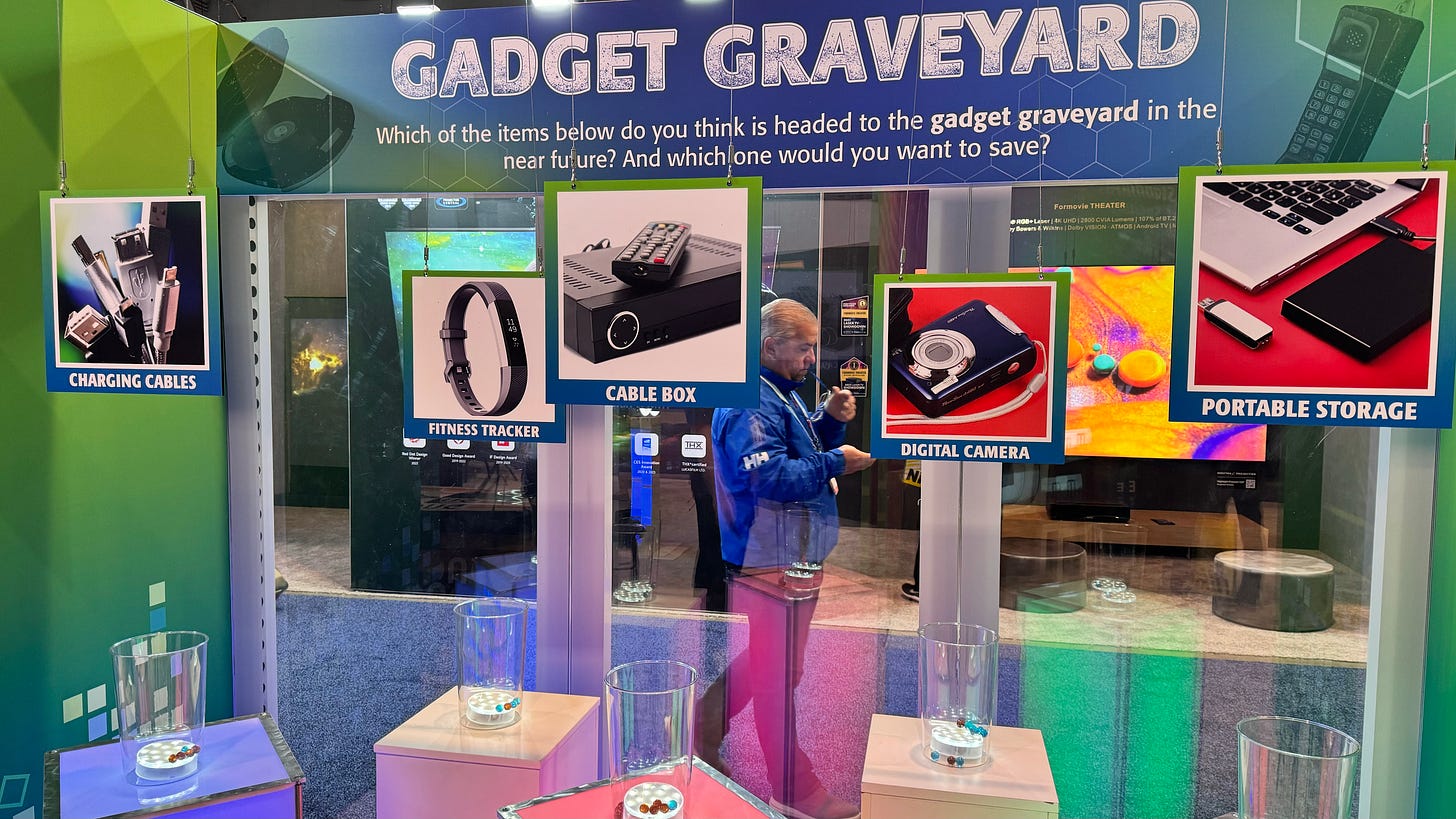
This year’s show was different because outside of automobiles and XR (VR, AR, goggles, etc.) most products seemed rather grounded. There was much less “bits and parts” or “vapor” than past years. If you’re not tuned in that can seems a little bit boring because things you can actually touch and use are also things that can let you down or not do everything one could imagine.
That isn’t to say there was not a lot of marketing that was little more than hype. In particular the show responded to the rise of ChatGPT with an all out assault on the use of “AI” in signage, naming, branding, and talk tracks. It clearly reached comical proportions. You have to go back to the launch of Alexa and before that the “WWW” to see such an abuse of a term.
Samsung, perhaps representative of the relative dullness of the mega-tech companies, was all-in on AI. I was in their booth reading a sign about AI being used in some sort of dish washer and two of the staffers approached me (this was end of show Friday). I chuckled and I said to them “looks like you got the memo on using AI in the description”. They sheepishly (and perhaps exhausted from 4 days of booth duty) confided in me that there was indeed a memo from corporate that all signs and descriptions needed to feature AI and all answers to questions needed to highlight the AI components—real, stretch, or imagined—of any product.
At the risk of being too judgmental or harsh, the mega companies did seem to lack a presence worthy of their on-floor footprint this year. Samsung and LG (Korea) and TCL and Haier (China) have an enormous product breadth highlighting everything from refrigerators to air conditioners to televisions but this year they were even challenged to show incremental improvements. As we’ll see below, Korea is in a battle over dominance of transparent LED screens which were I believe the biggest news of the show and had little to do with AI.
Google was touting the “New Android” which I did not find a precise definition. PC makers, huge companies that they are, seemed to remain stuck in their battle to make convertible, bending, folding, multi-screen laptops which do not seem to have the software or OS support to make workable. The major car makers continue to drive immense foot traffic, but they are also stuck showing prototypes that seem divorced entirely from their product development processes. Apple of course tried to upstage CES with an announcement of AVP on Monday (Apple announced the iPhone at an event smack in the middle of CES in 2007 when many of us raced down to see that). Microsoft, Intel, and most others receded to private areas for meetings. Sony, long the anchor of the show had a booth much more clearly focused on their growth area which is the technology underpinning professional broadcast and media, with no cars or end-user devices.
That’s the cynical side. It would be easy to feel that way about everything if you spent all your time in the Central LVCC hall where these booths take up enormous spaces. But that would be the wrong way to visit CES and see what is going on. Those booths are amply covered by the likes of CNN and BBC as well as industry trade press. Much to my surprise—and a pleasant one—this year saw a the most interesting things off the beaten path even among the “country” booths which have long been more Shark Tank and less “technology innovation”.
I left this year exhausted and admittedly while I have a good collection of themes, there was just too much to cover in a report. I’m going to do the best I can but what I would say is that the industry is incredibly healthy. There is a wave of innovative and inventive products that might not end up in our homes, pockets, offices but will certainly prove foundational or influential to product that will.
It is extremely clear from this year’s CES that we are seeing an “unbundling” of the smartphone. The reason is because the phone platform is rock solid stable at this point and for the incumbents it is far too difficult to add something dramatically new. Additionally, the phone isn’t necessarily the right place to add a new sensor. The plethora of “XR” glasses and phone companion devices show that sensors (incl cameras) are going to be added elsewhere. Because of the maturity of the supply chain these might not even need a phone, or they might use a phone, and even if they use a phone it won’t be permanently tethered. We’ve seen this with PCs where phones were at first accessories to PCs then left PCs in the dust. At some point the Watch will leave the Phone in the dust as well. Besides that none of the scenarios enabled by new devices will necessarily be ubiquitous enough that the phone makers will decide to tightly integrate them with a phone. In other words, we might have reached the limit of bundling new things with the phone if they are to get any traction. Or said another way, it is far more likely the next sensor or life accessory we all use might involve using a phone, but the phone will not be a threat to replacing it.
It is extremely clear from this year’s CES that we are seeing an “unbundling” of the smartphone.
Also, my feet hurt a huge amount on Thursday because I accidentally went to a TaeBo-like boxing class instead of yoga (went in the wrong door of the studio). As usual, I want to point out that I’m just one person walking the show systematically with no support or help. This is exactly what I have done for the last 25 years or so. What I lack in ability to (quickly) cover everything I hope to make up for with some experience in being able to see the changes over time from one vantage point. I’m positive I missed things and equally certain I misunderstood the importance (or not) of other things. I’m not expert in everything by any stretch and the breadth of products at #CES2024 especially the long tail of innovation (such as health, medical, biology) far exceeds one person’s ability to know the state of the art or project forward. Some things new to me might be old hat to those skilled in the art. Some things I think of as cool might already be shown to “not work”. Any mistakes are mine and if I misrepresent a product that you work on please give me a chance to correct it.
Note, I’m not here for referral links or anything. I have no affiliation with anything mentioned and won’t link to companies on purpose. All photos are mine unless otherwise indicated. Not only do my feet hurt but I’m exhausted! Disclosure: I was a CES judge for some categories but that did not influence anything I wrote here. I actually voted months ago.
Also please excuse any typos. I will happily fix any bad ones if you let me know.
The remainder of this report will showcase what I saw as highlights across the following dimensions:
Supply Chain
eInk and Photovoltaics
Organic Plastics
AI
TV
Improving Life, Homes, and Health
Glasses
Batteries and EV/Cars/Transport
Its a MagSafe and Qi2 world
Supply Chain
One of the first things I start with is a trip to the Westgate (if you’re not familiar this is the old Las Vegas Hilton where Elvis appeared late in life and also the hotel The Whyte House in Diamonds are Forever). The booths in this area are the lowest level of the CE stack and represent the components that are used in low volume manufacturing, prototyping, and custom development. As you walk through this area you can see people discussing everything from batteries to power supplies to PCBs to screens, cameras, sensors, and radios. Deals get done here and it is always exciting to watch.
What is seen here is important because it gives one a sense of what can be achieved if you’re not building a device entirely yourself. Unless you’re Apple or Samsung, chances are small that you can do that. I was somewhat concerned about this area going to the show because with all the tensions with China and the feeling that everyone wants to move out it could really spell trouble for the innovation pipeline.
In that sense it was good to see the area was healthy and while the vast majority of booths were from Shenzhen there were increasing numbers of booths from Vietnam, Singapore, and Malaysia, and even a booth from Kyrgyzstan. I worry it will become increasingly difficult to just “go to China” and pull together a new device. The vendors don’t think about these challenges, but it is clear they are on the minds of people that make stuff. No one wants to invest in building out a new dependency in such a fragile market.
That said, what amazes me is just how mature and ready to go the technologies have become. There are “OEM-ready” camera assemblies, wrist-sized computers, home control device with Matter support and more. If you have an idea for these you can get going very quickly.
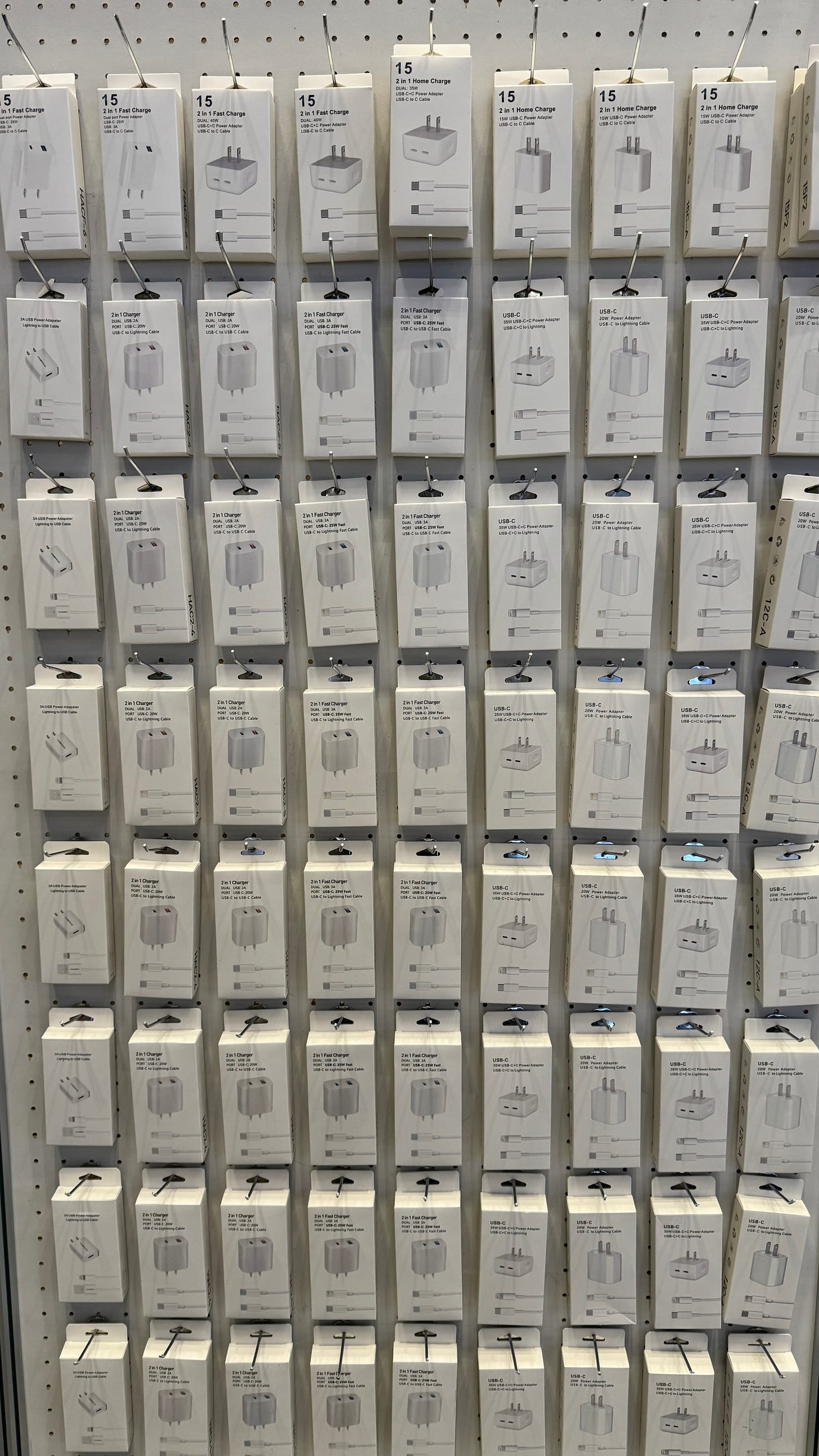
The expertise and stack of technologies has been decades in the making. Policy makers (on both sides) need to consider that there no “unwinding” this or “substituting” for this that can happen quickly. It is trillions of dollars, and that’s not even accounting for Taiwan and core chips.
As I walked the rest of the show, the contribution from Shenzhen was clearly visible everywhere. Sometimes even at overt levels. One example was a new home lock (below) from Dutch company Philips which flat out says “we just went to China and created a joint venture” and let them do their thing with an HQ in the US.
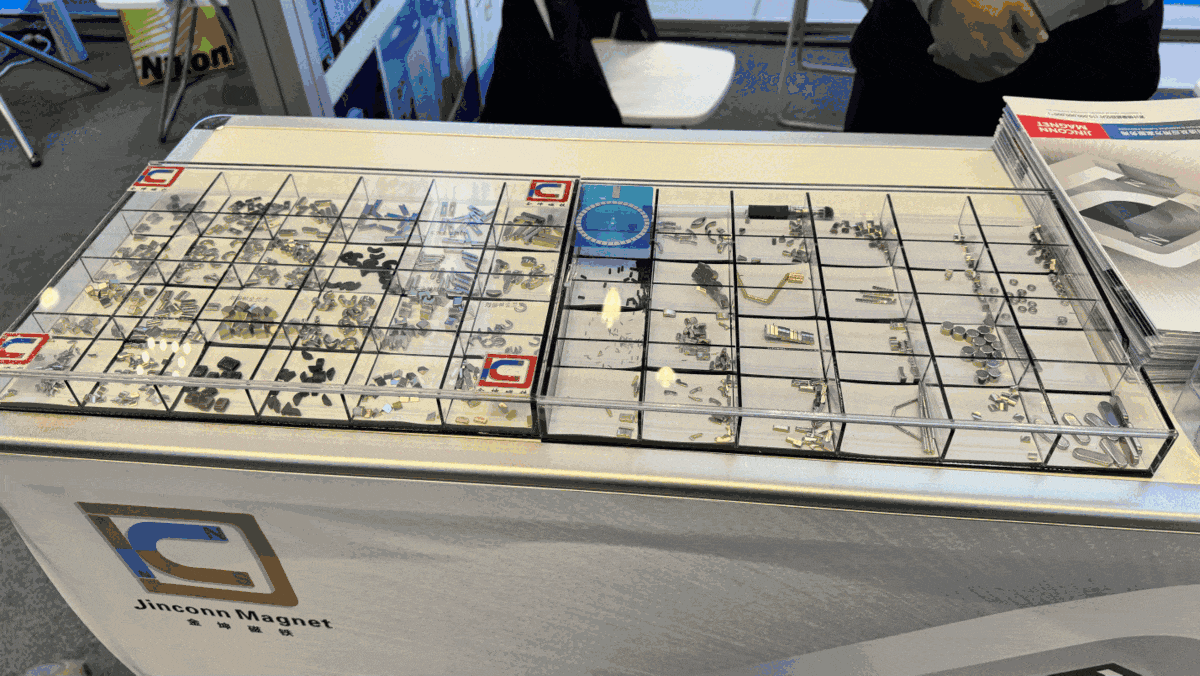
Favorites in emerging or finally emerged technologies: eInk and Photovolatics
Sometimes I go the show year after year and see the same thing and wonder when will it go away so we can move on and then surprise someone uses a technology for a new product and a crazy nascent technology is all of a sudden mainstream. Three things hit me like a ton of bricks this year and I could not be more excited.
eInk displays have been part of CES for probably 30 years—the GM of Word in the 90s was an MIT Media Lab graduate who worked on the technology long before Microsoft. I know they were here before I made my first trip. They languished forever. They really hit a low point when right when one had hoped they would rise up which was the internet. While the internet demanded a scenario for a “browsing device” the eInk display was poorly suited to that as it couldn’t show pictures, videos, or even render pages (the big UI element then was the “image map” which totally did not work).
Then along came the Amazon Kindle. Suddenly the display had a whole new life and an incredibly successful product that brought together the internet, WWAN chipsets, and a book store. For the next few years, the show floor was littered with eInk displays from every manufacturer with their own book store. But there the technology seemed to hit a wall.
Engineers kept grinding away on the technology. The benefits of incredibly crisp text, super low power consumption, and ever-shrinking and low-cost bluetooth and wifi have made ample room for product managers to find a scenario that works. During this time the screens have gained quality and expanding implementation to include other “paper-like” technologies. They now have color as well.
Sharp and Panasonic are two companies that have been working on this for sometime and both showed digital signs using the technology. Sharp in particular already has a line of “industrial” displays used for signs (like airports, retail, malls, etc.) that include a centralized control and content management system. These are at the high end.
At the small end eInk displays have found a niche in some grocery stores and places like Bestbuy where they can be programmed and managed as a fleet. They fit in to a standardized slot in retail shelving and allow for easy changes when stock moves around or prices change. They can be controlled by a “fleet” management system as well.
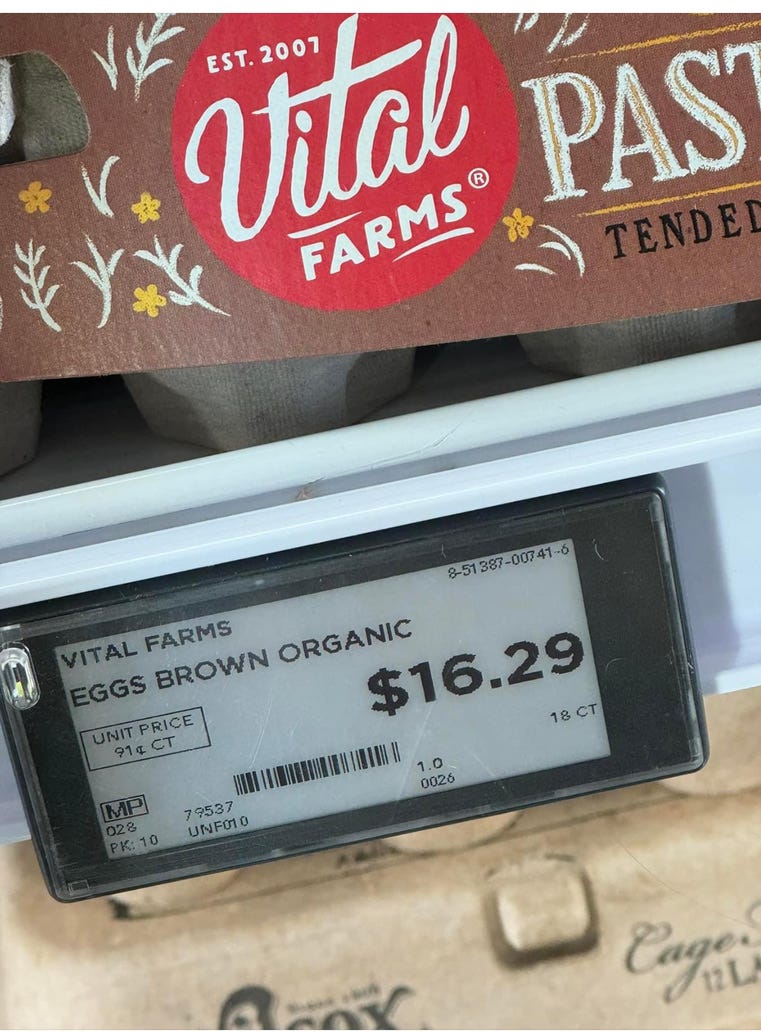
These screens have even made their way into Instagram products you see all the time. Here’s a stock ticker—there’s an app you download and connect to the device to tell it which stock to follow.
Each of these examples shows a technology that was left for dead being used in brand new products in broadly scaled markets. BUT they all have one problem, which is even with low-power these are all powered devices. That’s where the next technology that has been around forever comes in—ambient light photovoltaics.
I’ve been using the Logitech solar keyboard for probably 12+ years (whenever it came out). It’s my favorite keyboard and I was so afraid they would stop making it I have a couple of extras. Two problems with it, one is that the photovoltaic strip is giant and takes up the top row of the keyboard and the other is that the mouse still uses batteries. If you use an Apple Magic keyb/tp then you know the absurd situation where in right now which is keeping around a lighting cable to charge those every 8-12 weeks.
Then along come at least two different companies that have been engineering and prototyping their way to improve photovoltaics and how they charge with minimal ambient light. This is just inventing stuff and it is working. I had an enormously fun conversation with a designer at a foundational company building these postage stamp sized solar cells to power devices. He spends time working with potential customers on how to solve their product needs using battery-less ambient light. By coincidence he’s a Silicon Valley native and has made his way through quite a few memorable projects. Meeting people like this on the floor is pure joy!
The company, Ambient Photonics, had a whole host of potential devices showing off the use of their cells to make battery-less devices. My favorite was a TV remote. They had a model for an Amazon Fire remote where the cell just takes up the middle of the direction pad. Another favorite was a door alarm contact sensor. Today these things are huge and take an expensive C123 Lithium cell that you have to run around the house and change every year or so. Putting on an ambient light cell and the sensor gets smaller and no-touch. Same for a smoke alarm listener.
He also solve the mouse problem. Because the cells have gotten something like 30-40% more efficient they don’t need line of sight to the ambient light. So he took an off the shelf mouse and put a translucent top on it and under that put the cell. Now there’s a mouse powered by the ambient light. Assuming there’s a good choice of material a trackpad gets even easier because there is more surface area.
Another company that makes cells was showing off these headphones which are powered by the cell on the top. These can be used for a couple of hours and then they need to be turned off while they charge. I think the combination of larger batteries and devices used intermittently will make for a powerful (ha) combination. The only problem is those devices will have some maintenance. An example of such a device might be a hands-free faucet.
So by itself this evolution in ambient light power would be super interesting. But what comes next is combining the ability to power these connected and low-power devices while also adding an eInk screen. So now you can put out price tags or signs all over the place and do so without needing to connect them to power. Even better because they connect over bluetooth there’s no wires at all which makes them much more flexible to install and maintain.
The Sharp example above shows a more visible capture panel above the device. I think the aesthetics work and are certainly worth the tradeoff. The staff told me it could fresh frequently in typical lighting available to signs. You would not use it for a billboard or outdoor signage necessarily but in a retail setting or any office/hotel setting it would be fantastic. All remotely administered.
Then back to our price labels. Because of the improvement in light capture, the labels can have the cells located almost anywhere and fit smoothly in the shelf rail and never have to be touched unless the stock needs rearranging.
Finally, the eInk displays have gotten so efficient that you can put one on a device and power it wirelessly literally by the NFC contactless connection. Erisco was a booth in the "Eureka” section of the show (all small form factor booths almost always with the inventor). Erisco is a keyless-NFC lock (actually it has a key for backup) that has an eInk display. You operate the lock using an App that unlocks via NFC. When it unlocks the screen refreshes with the time/user that operated the lock (and also updates a record in the cloud). The lock doesn’t need an additional power source. So super cool.
This security scenario shows up in many other places such as mailboxes for secure package delivery as we’ll see. Other places such a sensors for temperature and humidity (even connected to HomeKit), smoke/fire, etc. will be incredibly cool to have—you can have so many more of these if you don’t need to worry about plugging them in or changing batteries.
I have to say I was kind of blown away by the coming together of eInk and ambient photovoltaics along with bluetooth/NFC. I really believe this is a revolution and we’ll see so many devices that we used to hassle with when it comes to batteries. It is only because people kept working on these foundational technologies and improving them and also integrating with other technologies.
Organic Plastics
Another technology that’s been talked about forever and made little progress has been organic plastics. With every booth touting how green and climate friendly they are it can get tiresome especially when everything seems to arrive packed in foam and plastic. But we are on the verge of new kinds of plastics which have the advantage of being durable while requiring no petroleum and when discarded decay in just a couple of months.
I happened to buy my first organic plastic gadget in Japan six months ago, but couldn’t read the Japanese. I just thought it was the cool new shaver from Panasonic. Turns out it was made with a plant-based plastic they created. Not only that but they used the new shaver as a chance to revisit the whole form factor and made a “nature-shaped” shaver charged by USB.
Just about every company has some green section in their booth. Almost all of them are just corporate speak. It was great to see this innovation and knowing that I already have one of the products in market it was super cool to see. I suspect we will see more and more made from these materials. Right now they are “high end” focused but that is just time. I spoke at length with an engineer about the energy profile of using these materials and they are confident that no matter how they are measured the environmental impact is far less with these new materials. Let’s see how things evolve.
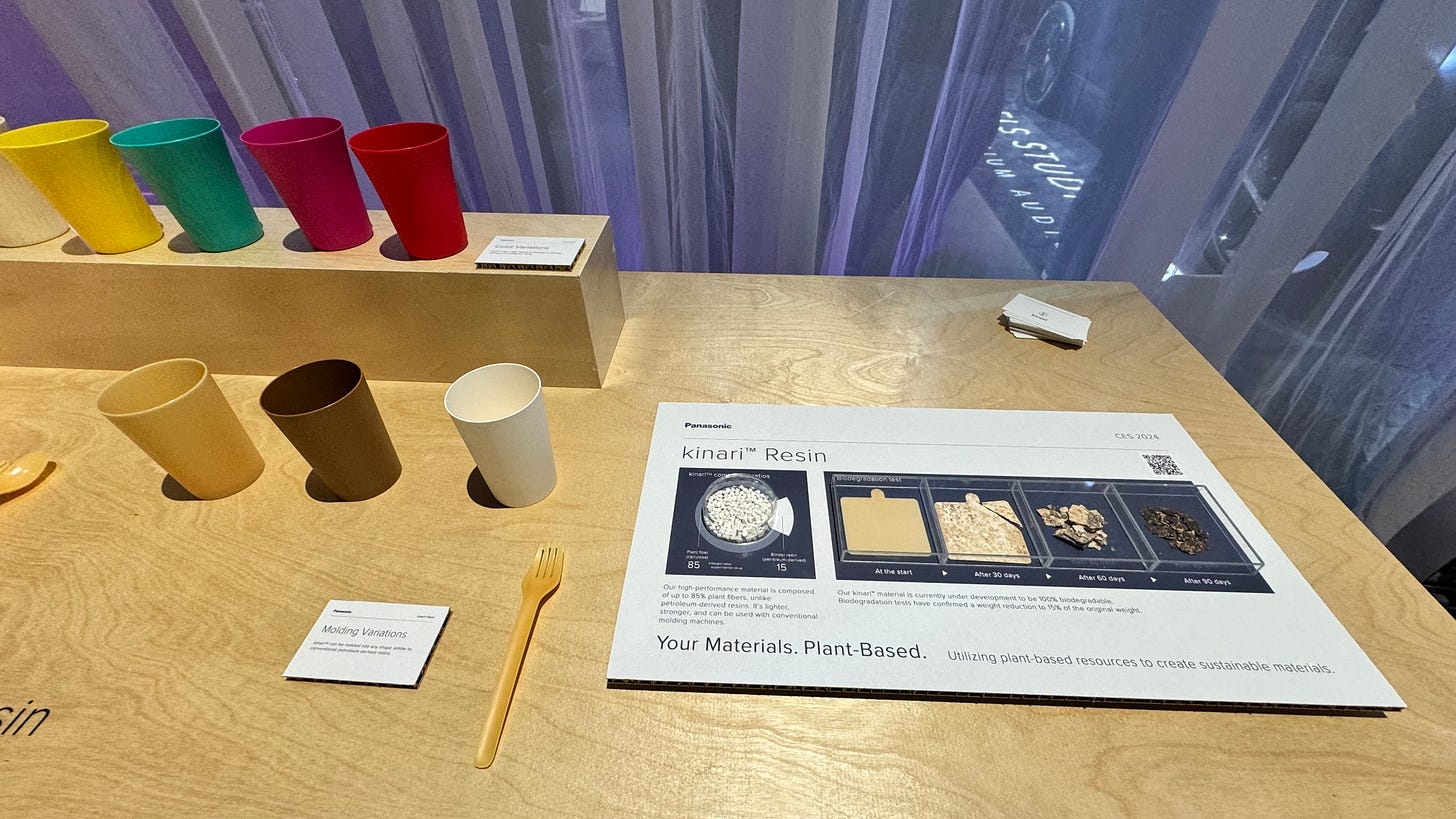
AI
By the end of the first day I had had enough of hearing about AI. But because I’m old and have seen this kind of hype cycle before, every time I heard “AI” I just substituted “MP3” or “home theater” and kept moving. AI came far too late in the year to actually impact any products and so by and large one could safely ignore the “AI” part of any product description.
The use of generative AI seemed to be used behind the scenes with “because we could” demos usually to do with robots or other virtual assistants. Basically just what you’d expect, a voice query and a call to ChatGPT to return an answer that isn’t quite right.
At this point the whole of CES got interrupted by the launch of the Rabbit R1 AI assistant. This was great marketing and last I checked three production runs were sold out (I ordered one of course). It is too easy to be “this is the future” or “this won’t work” and I can easily and probably adeptly argue both sides. Rather than do that here, I would just caution that no one has ever successfully disintermediated apps. I spent many years working on apps/Office and listening to arguments from the Platforms/Systems world about how apps will “go away” or get turned into very small things. Here we are today where apps are bigger and do more than ever before. Systems tends to think apps can be replaced and mostly it is because systems people don’t quite understand what apps do and where apps people think the value is that they add. Soon the platform finds it needs to build all the apps to solve the customer problem, and building apps is really difficult, especially all of them. But let’s reserve judgement for now.
I want to expand on this point a bit after some back and forth post publication. It takes a long time for apps to get recast for a new platform. The network computer presaged chromebooks—a laptop device that only ran a browser. It was conceived by “systems” people who had a view that apps were easily moved to a web platform. It took about 15 years for apps to be web (and that is still happening) and for the web to support older scenarios in entirely new ways. Even then many scenarios became mobile first/only before web, such as photos. For Rabbit to have apps it will take a long time for important apps to become AI (and by that we mostly mean voice) first. It will also take a long time for voice first/only implementations of many key scenarios to be conceived and developed. I am not being negative but offering an apps view of how apps can “get consumed” by a new platform and by that I mean “be transformed” to a new platform. There’s always a chance for an “Apple Watch” play which means by and large that “all” (not really) the apps get done by the platform.
Samsung has another new personal assistant robot, this one named Ballie. It is a front end to SmartThings home control platform as well as integrates with other content parts of Samsung. The robot also has a laser projector built in. I’m going to reserve judgement on all of this until “OK Google” or “Siri” can successfully and repeatedly lock/unlock my front door.
OK back to optimism. What is super clear is that the AI around images, audio, translation, and recognition is mature enough that it is just in products now and it works. It works spectacularly well. It used to be when you saw a demo of translation or image recognition you focused much less on the scenario and much more wondering how often it would be wrong. Now the products are real. You can use them. And you can focus on if the form factor, user experience, scenario and so on all make sense and are worth buying. It is simply amazing.
I’m going to start with my absolute favorite of the entire show. TranscribeGlass from right down the street on Stevens Creek Rd (where PowerPoint used to be!). This is a device that clips to eyeglasses and shows realtime dialog (speech recognition) or translation. You don’t need a new pair of special glasses. You don’t need a tethered battery back. The clip-on gadget connected via BT to the phone. Then people talk and you just see the text. It is purpose-built for this scenario and it works. I used it.
The software also understands some of the specific captioning used in classrooms and is able to work with that. It is mind blowing. If you think about this scenario some might be quick to say to just use XR glasses or the new Meta glasses, but the problem is you need those to be expensive and you lose out on the personalization and fashion of glasses. Plus in the deaf community you might need to clip this on just for class or a meeting and then clip it off and then you can wear prescription or sunglasses (or safety glasses at work) or whatever.
I just love this product. Love that the CEO was there. Look, here’s their photo from X. Those are boxes with the product. They have sold upwards of 10K units. That’s the founder CEO who studied this whole area at Stanford. ❤️❤️❤️ Absolute best in show.
EssilorLuxottica the global eyewear giant announced a product Nuance Audio which is a hearing assist technology built into the glasses but will not be in market until late 2024 and I did not see/hear a demo. The other end of the spectrum.
“Translators” have been a mainstay of the Asian consumer electronics market for a long time. While English is the common business language the work between Japan, China, Korea, Vietnam has kept these translators as standard issue. While many of us have been wowed by the Google translate app, it is still not unusual to see the dedicated devices.
Timekettle from China has a whole variety of LLM-based translation devices. They all worked right there on the show floor and were quite good. It was fun to watch people listening on earbuds (there were a number of real time earbud products) or using the Trek-like universal translator that captured audio, transcribed it, and translated it. These work offline and don’t require a connection in real time for many language pairs and support online for 40+ languages and over 90 accents. They also support photo. This is also an example of the difference between an “app-driven” innovation and a platform. The google app, for example, is mostly a surfacing of their API but these devices have a whole set of features available to facilities many translation scenarios (like multiple speakers, asking directions, etc.
Another form factor for translation and transcription was a credit card sized device called PLAUD that magsafes/sticks to the back of your phone. It provides 30 hours of continuous recording. It also summarizes via ChatGPT. Another purpose built device that could be an app (and for most is) but the device frees up phone or is used when you can’t bring your phone or something.
Glidance brings AI to assisting with vision impaired or vision loss. Without underselling or mischaracterizing it, it is almost like a super cane. It uses a combination of recognition and interface technologies to assist in navigating the world. It is an incredible demo. It is the kind of booth where people who would benefit from the technology stop by and use it for the first time and you can observe their reactions.
Contuning with the way image processing is just a tool that can be used, some fishery managers in Japan (think fish farms) developed a high speed recognition camera that can track the fish in a farm as to their weight and size and alert the monitor as to when they are ready to be harvested. I did not know but the standard way of operating these farms requires fish to periodically removed and sampled to be weighed which really bugs the fish and risks bruising or harming them. Now they just watch a monitor for when they reach the right size for harvesting.
The most surprising use of AI less with imaging but more with traditional data processing and patterns was another aquatic product. This one is almost as crazy as it sounds. It is called molluSCAN: The Connected Oysters. A team of French marine biologists developed a set of sensors that they attach to oysters which then send their signals to a buoy and then up to a cloud. The sensors are basic biological signs for the oysters—the human equivalent to blood pressure, heart rate, labs, etc. (that’s what he told me). They were busy doing their research and having lots of good data. Then they realized that the oysters serve as an early warning for environmental and climate issues. When something changes in the ocean the oysters biology changes. They see the patterns very quickly. For example there was an oil spill in a platform and the oysters knew right away and they were able to locate it before the offshore rig knew what was going on (they told me). So now they just want to offer the product as a way of monitoring the oceans. Like an idiot I asked them if they have to dive into the ocean and attach them (like they do the tags on sharks) and he looked at me funny. No they just bring in oysters native to the region with tags already attached and drop them in the ocean. I then (again like an idiot) asked if the wires need to be really long in case the oysters swim away. He again looked at me funny and explained that oysters don’t move. So there you have it. It was super interesting and real world use of AI.

There were a great many robots at the show. For years the industrial robots have been improving and these now are routine in warehouses. This year there were far too many robots to make coffee or pour a glass of beer.
Samsung’s home robot debuted again as well. There was also a new one from a startup in the “toy” space called Loona. It is a fun robot with a lot of processing power and a developer platform.
The role of AI in security is well-understood and as we know there is no shortage of companies in the security camera and monitoring business coming out of China. Their work has been a major export and is used around the world as part of China’s Belt and Road initiative. Many of these companies exhibit at CES and show the software systems they sell. It is difficult to be comforted by the growing use of these in the US where the patchwork of regulatory and privacy efforts mean we have few protections and controls as individuals.
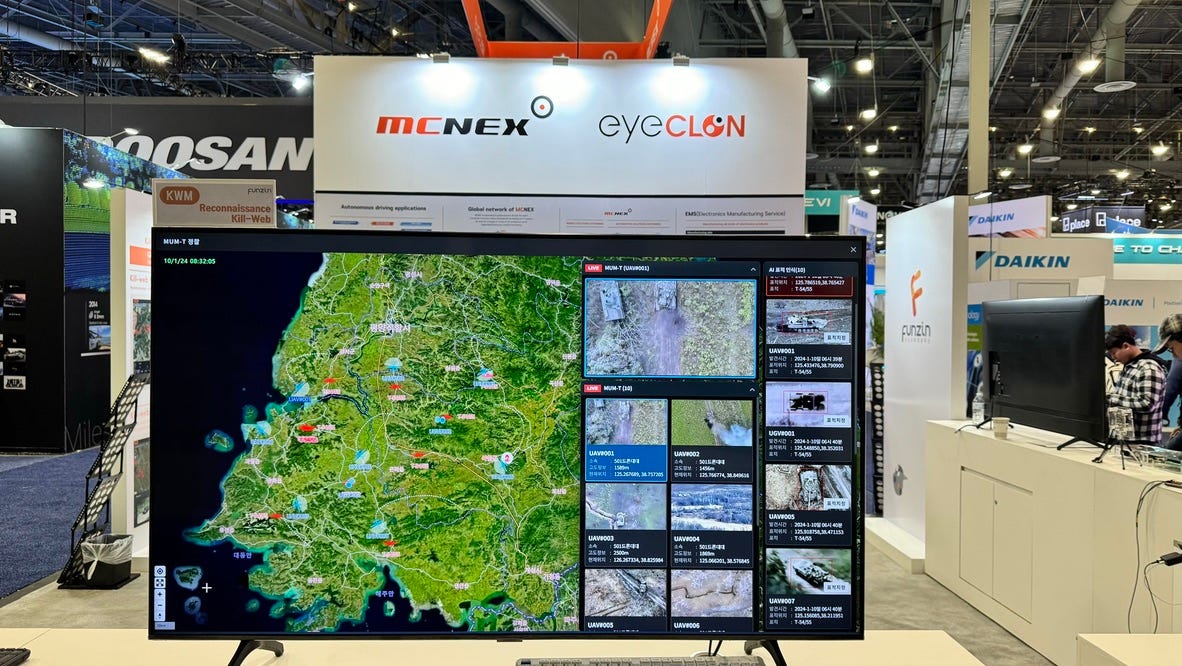
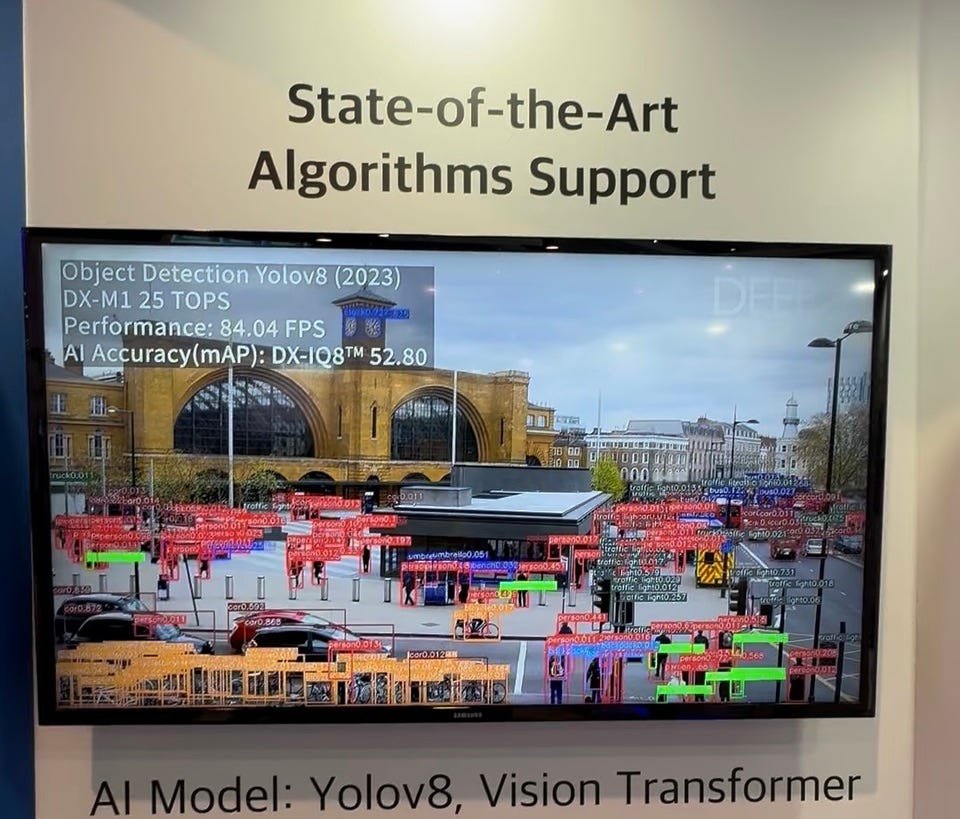
A company in Korea uses image recognition and a unique AI model to discern pollution and particulate levels in the air by analyzing images over time from any security camera. They are also able to use recycled Samsung phones as endpoints in the air quality monitoring system. The device in the image below is a screen from a Samsung phone, blue is a good air quality color. It is kind of crazy to think they are computing air quality by studying crappy security camera images but that’s what they do. It is deployed already.
At some point the AI stuck on to everything is out of control. This is an “AI” bath mat.
TV
In the tradition of CES, the biggest news always comes from televisions. There is such a demand for TV to be the big news that we’re all pretty exhausted from several recent attempts to create news about TV. I think it is fair to say that 3D images, flexible tv, and while the jury is still out folding screens don’t see to be the thing. BUT this year surprised everyone with a super cool unveiling of transparent OLED screens. They called them transparent but technically they are more translucent. Unlike the past technologies, they are not reaching for the home market with transparent. The commercial uses seem justified and cool. LG will be first to market but Samsung will be close behind. So LG won CES in this regard.

I spent time time chatting with a designer who is tasked with prototyping uses for clear screens. As an indication of just how little news their was in the big booths, this person had plenty of time and the company had no problem using about 100 ft² of booth space for a non-shipping “sketch” of potential uses. It is always great to get to chat with these folks casually. This designer made an audio-first device that used analog tubes to amplify the sound while providing modern connectivity to music. The screen shows the artist/album or you can see through it and see the tubes. Or you can show video or a fireplace for example.
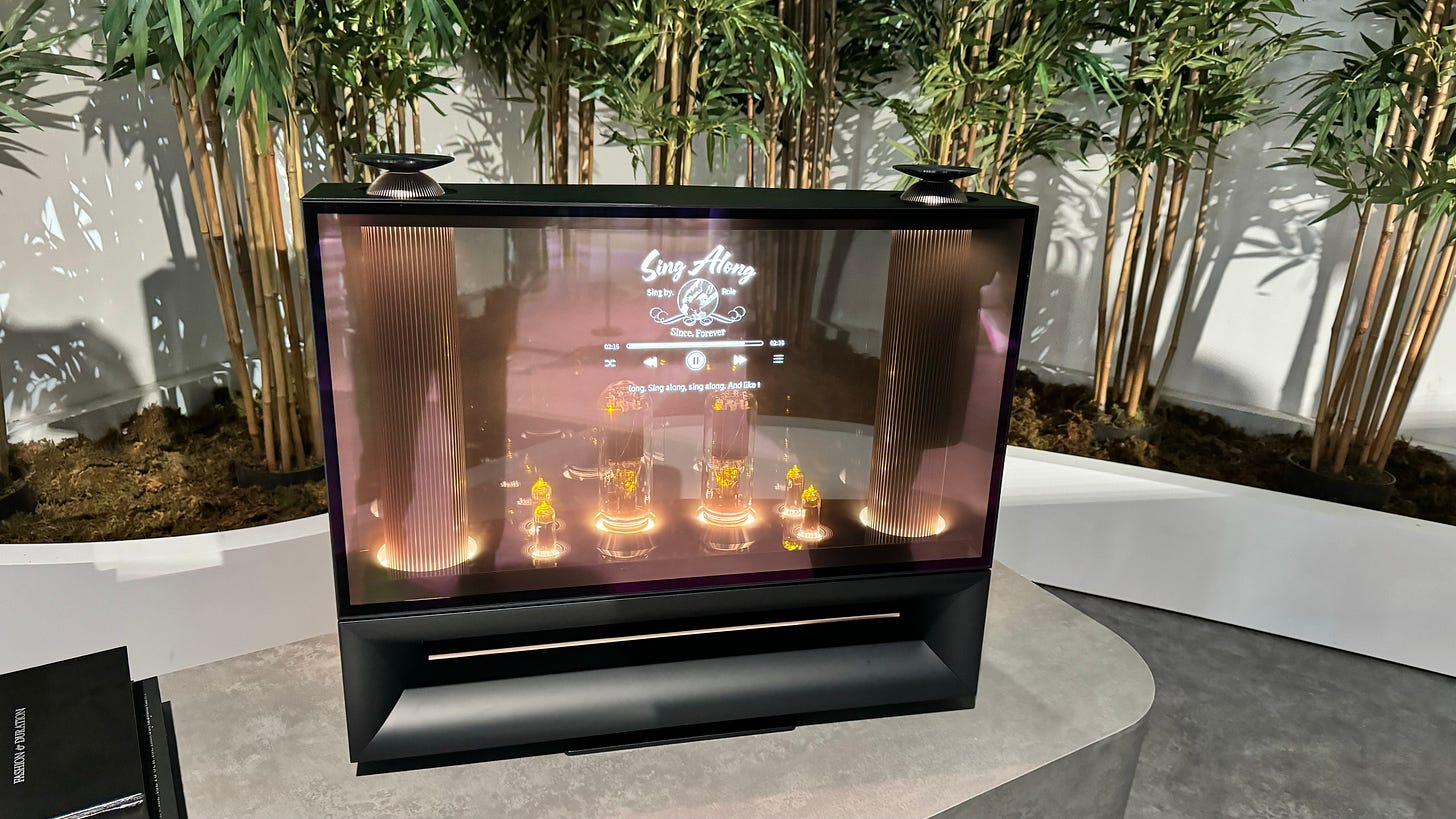
There’s an ongoing iterative improvement in consumer TVs using LED. It is super interesting to wonder how long before OLED consumes LED. There’s a significant price difference now but the QD Micro-LED TVs are also super thin and relatively low cost. TCL (China) routinely sells the really big TVs at best buy and even had a cool demo to show how much better it is to have a 98” or 115” tv at home. It is tough to argue with them.
Editorial: My problem with the consumer TVs remains the software load. I just can’t stand the LG or Samsung software and can’t see buying a TV with it. There’s no way to keep it a “dumb” monitor. I’ve switched out my LG to use a Sony since I use google TV and love it. I even love Sony w/ Google TV when using Apple TV because the Google software stays quiet when connected to another input. It’s just the constant ‘updates’ and more not to mention all the bytes over the wire I don’t understand. I need to get over this or just buy a commercial display.
Two other TV technologies continue to improve. The customizable size panel Micro LED TVs are getting huge and relatively cost-effective. In past years you could walk up to any of these and the hot air around them was noticeable and there’s no way you could use these in anything but a giant exhibit or ballroom space. They seem to have solved this problem at least with all the display units. They are much more commercialized now though still available through custom installers.
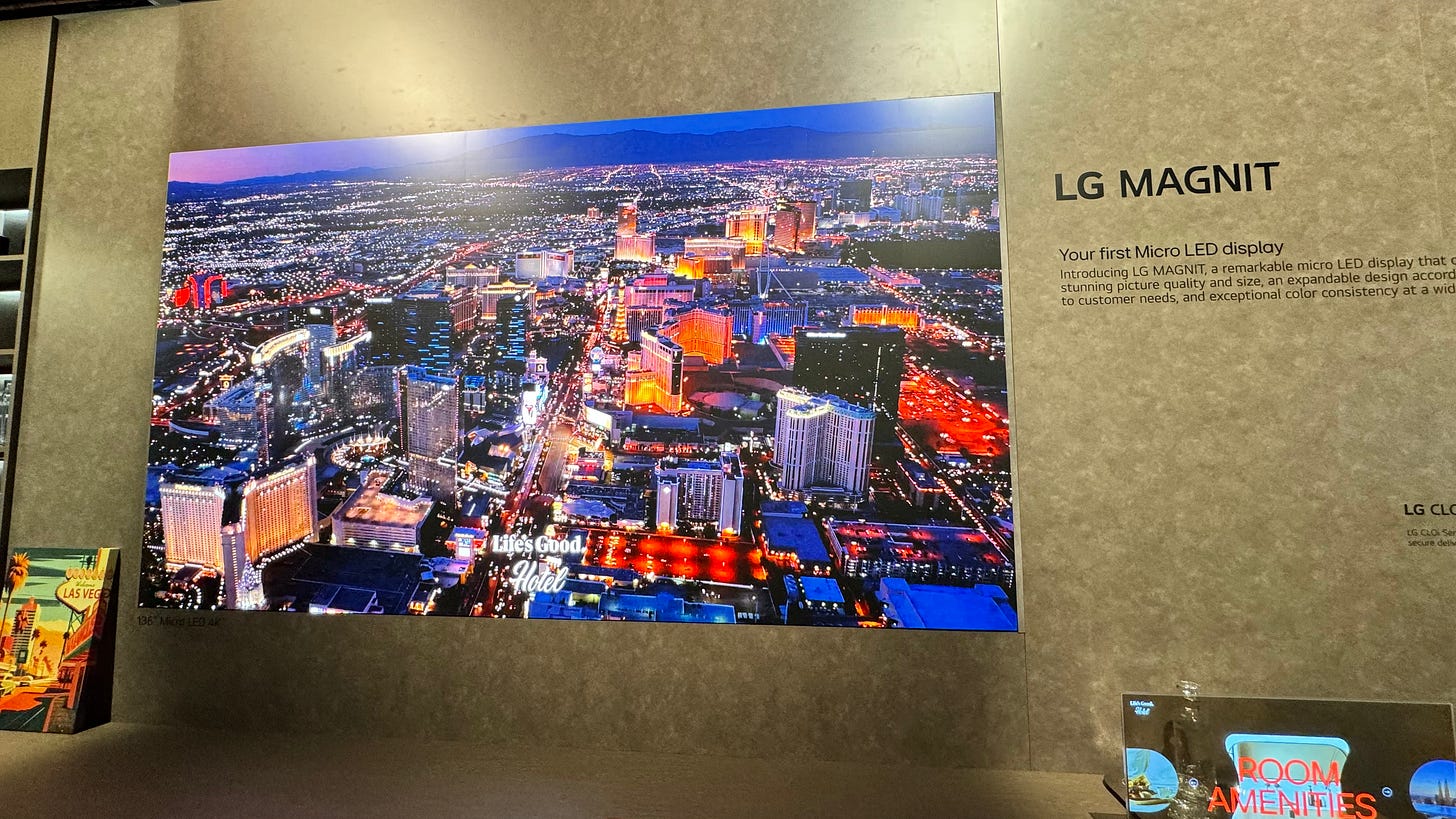
The other technology that is definitely mainstream now and has moved from exotic just a couple of years ago is laser projection. The short throw laser TVs are super cool. I don’t know if anyone wants to go back to a world of screens but above a certain size the exponential cost of a panel is so high the lasers become economical. There are several that look like furniture consoles and the screen unrolls from inside and the projection comes out of the top or slides out from underneath. They also have a ton of image processing so you can use 4 of them to make a huge image or stitch two together for an ultra wide one (like in a presentation room). China manufacturers are pushing hard on this because there was a top down initiative to “win” in laser projection.
I love this use of transparent TV for commercial. Here the panel is in front of the plexiglass.
The other big news for TV was the arrival of NextGen ATSC or standard and free off-air TV. It is amazing to think in 2024 this might be cool again. For kids out there, this is tv that requires an antenna and a coax cable. The antenna can sometimes be inside right on top of the TV like when I was a kid. But more likely to get all available channels you’ll need some larger antenna mounted on a roof and probably need to spend time aiming it. The web side antennaweb.org can tell you what channels are available and kind of antenna you can use and which way to point it.
Most TVs now come with a COAX to accept the signal and tune it. But what is new is that there is a whole set of information and program guide available (for free). The various tuners (either the TV or a secondary box) offer different levels of tuning and even features like DVR. What’s old is new.
We live in a multi-user building that has off air so I can play with this. It is neat for big events on broadcast because when streamed or over Comcast there is a slight delay (and also different ads). It always works unless the antenna is down.
Of course the biggest use is in places not served by cable AND high speed internet (while I was at CES, Hughes satellite announced another quarter of loss of subscribers). Though the more rural you are the smaller the selection of channels. I was surprised at how many channels Seattle gets. Local stations are obligated to transmit and almost like AM radio there are a whole collection of channels and many in Spanish and Chinese depending on where you live.
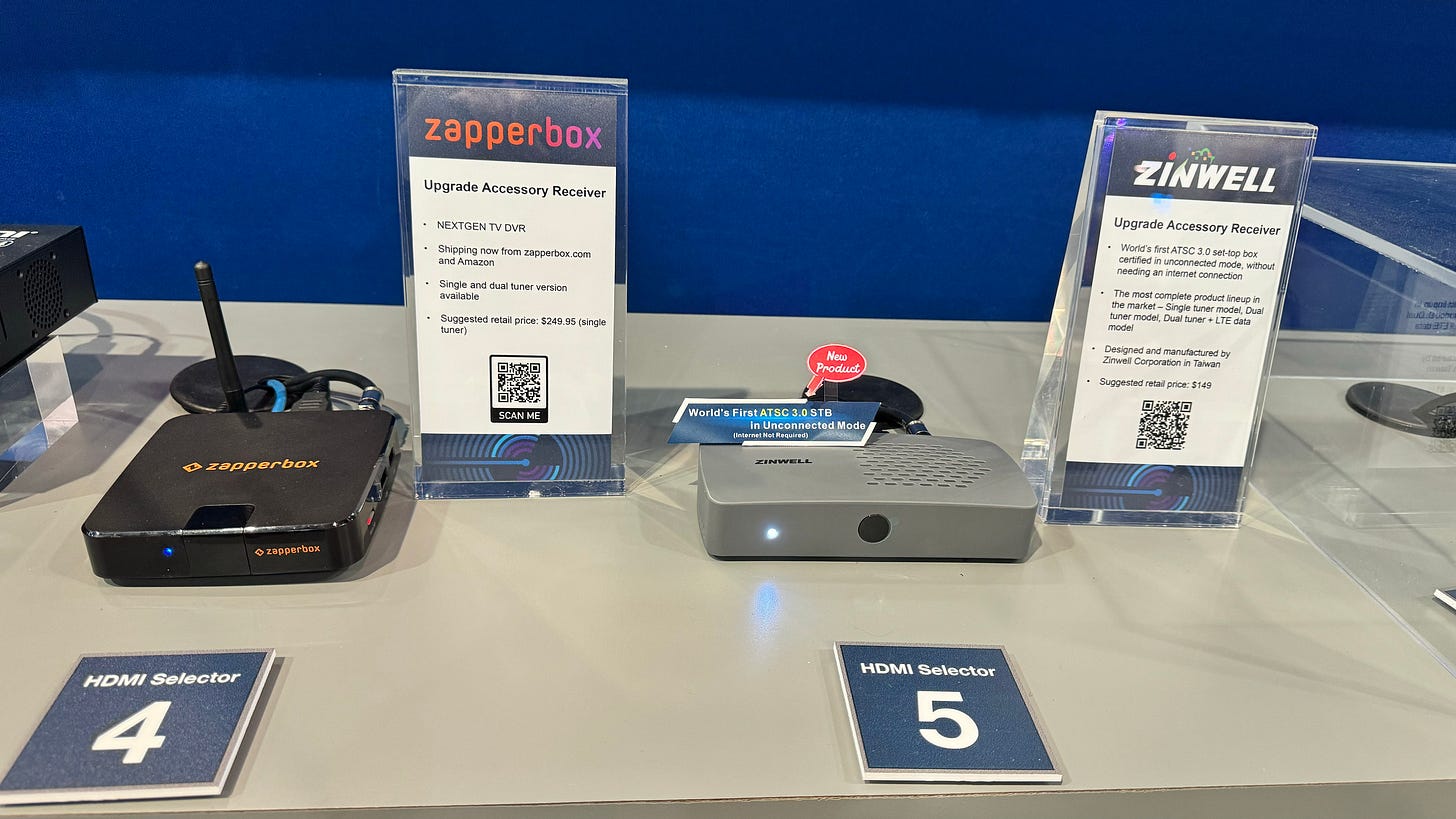
Improving Life, Homes, and Health
A good deal of the show floor across all the exhibit areas but the Eureka area in particular is devoted to general “improve quality of life” products. These can be seen as gadgets. They can be seen as a bit “Shark Tank”. Or they can be seen as things that someday we will all have and can’t imagine living without. Whenever I look at these I take myself back to Disney World and the GE Carousel of progress. What is a gadget one year turns into a common household item in a few years. Often in the middle it is cursed for not being reliable or worse being unnecessary. If you don’t know what I mean then here’s the video just so you can have the song stuck in your head.
Health has long been a tricky area for me to cover. While I benefit from a bunch of experience and being close to a doctor, I find too much of what is talked about as health at the show to be attempts to sell into healthcare without going through the science and regulatory work that it takes to truly sell healthcare. I tend to just avoid the pseudo-science products.
Even with that, many things might never be proven or it just doesn’t matter. There were dozens of pillows and mattresses to help people sleep better. If you try one and it helps, the more power too you. We could all use better sleep.
Likewise, I’m a big Apple Watch user and this year saw a number of new rings debut with various feature sets. Many prefer the ring for battery life or form factor (preferring to wear a real watch). They all tend to measure the same body telemetry though the software can provide many different interpretations.
Arguably, the most medically important but always out there body telemetry is blood glucose. Many of us have worn continuous monitors out of necessity or to learn about our bodies and eating. They work fantastically well but still have discomfort. Every year there are new non-invasive approaches to BGM that don’t seem to make it to market. It is a huge problem that will get solved. Tomato Crew from Korea announced a glucose (and other vital signs) monitor this year that uses laser light (like the Apple Watch uses for pulseOx and HR).
Ortiv uses the same micro-needle for glucose much like a CGM but is not a continuous monitor. They are another company from Korea.
Time will tell.
The second most critical measurement is blood pressure, long elusive in terms of easy measurement. There have been a few attempts at wrist based bands especially one from industry leader Omron (last year?) that have not it seems caught on. The Korean company CHARMCare has a new band and also a continuous 24h band they brought out this year. I am not sure how well this will work. Measuring BP has long been difficult.
The most noise in home health measurement came from Withings (which Nokia sold back to the original founder) makers of popular scales. Withings introduced “Beamo - revolutionary at-home checkup”. It is a device (plus accessories) that can measure body temperature, ECG, pulseOX, and a digital stethoscope. The latter is the big news as the other measures are already commodities or at least available readily as needed. It is all in one handy device. The basic idea is to connect with an MD over telemedicine so they can interpret the stethoscope. It isn’t clear how many conditions are readily identifiable from this.
A question many ask is how to apply AI to diagnostics. There are many products in the deep medical space for analyzing images. But at CES the casual and non-medical use is what makes an appearance (though to be fair there were quite a few CT, MRI, X-Ray analysis tools which require significant regulatory approval to deploy in the US).
But what about taking x-rays. The scariest device I saw was an x-ray that looked like a digital camera, the “MINE ALNU”. It is literally a digital camera with an x-ray sensor (like at the dentist) and an emitter. It is a portable diagnostic tool. It is not approved and fortunately the demo unit was non functional because of course the person playing with it pointed it straight at my face. It connects to device and the x-rays just show up there.
There were a number of “AI Mirrors” that are designed to look at your face and use learning algorithms to detect real measures like blood pressure and not so real measures like what mood are you in. I tried about a half dozen of these and none of them made it through the demo so I won’t dive into it too much. Nuralogix says they have peer reviewed articles and have studied 50,000 patients to train their model on “Affective AI”. These definitely had a Blade Runner feel in terms of using an image to determine if you were healthy (or a skin job).
Baby monitoring has long been a CES theme and each year there are new and innovative products. Capella.io is a a product that uses a repurposed phone (in other word’s baby’s first phone is a monitor) to listen to the crib and using an AI model it is able to determine what the baby is crying about (no really!): hunger, exhaustion, discomfort, even noise. They have a ton of data points and audio they have built the model around and claim high accuracy. They basically sell a clip for the phone you provide and an app/service.
Owlet is a body telemetry “sock” for babies that transmits to a dongle and then to a phone app. It has been in market for a while and is FDA approved. Owlet tracks pulse rate, oxygen, wakings, and sleep trends in real-time via the their Dream App.
For a brief time during Covid there was a home PCR test which seems to have vanished . Co-Dx has a generalized home PCR platform for use with diagnosing a number of viruses. They have a base unit that can handle multiple coded strips based on a sample from cheek, throat, nose. The strip seeking approval is Covid, quad-flu, RSV, and more I think.
Personal safety beyond endless home security cameras has seen a consistent rise in the number of products and the capabilities of these products. Home door locks have gotten very good and the latest ones that integrate with HomeKit are truly game changing—not just no keys, but no codes to tap. We need more of these.
Philips the giant Dutch company that makes everything had an innovative door lock that uses a camera to recognize your palm. You simply hold your palm in front of the lock and the door opens. Of course it supports bluetooth, codes, wifi, and a key. It has all the stuff you’d expect from a smart lock (except home/homekit integration). It was interesting that a vision impaired person stopped by the booth when I was there and really took a liking to the product which please the product manager quite a bit. The most interesting thing was it claimed 9-12 month battery life. That seemed optimistic.
Unbundling of personal safety is an interesting theme. Again, dedicated devices that do what an app can do on the phone but provide more capabilities in a form factor that can offer enhanced features. Two that caught my eye were about emergencies when you’re alone.

Sims Technology introduced the “Never Look Back” which is a small dongle you put on your back—it is a camera that faces backwards. You can wear it jogging or walking and it can notify you or take action if you are aggressively approached from behind. Like iOS emergency it can notify contacts and so on. It has been trained to look for aggressive approaches they told me.
Safee is a MagSafe device that attaches to an iPhone (or via a metal ring on green bubbles). It is like a super panic button (like the iOS SOS feature). What it does during setup is get permission for camera, microphone, and location. If you hit the button 3 times quickly it will sound a super loud alarm, begin a broadcast to the cloud using the phone camera and mic, and then handle emergency alert. It is regretful that things like this are looking more and more necessary if you live in a city.
I’ve become obsessed with Apple FindMy so I’ve been trying all the third party dongles and beacons. The UpFiner is basically a travel safe with FindMy built in. It has a motion sensor, alarm, geolocation (via FindMy) along with an app that provides the tools for setting the access code and so on. While you can use any safe and throw the dongle or AirTag in there this is just an integrated version of that.
Receiving packages securely is a new burden we all share. I’m lucky enough to have a garage and even luckier to have an opener that seems to mostly work with Amazon Key. But that only covers Amazon. For years there have been a variety of analog boxes but getting the carriers to use them is difficult. Then a Utah-based company created a product by connecting to web services and using tracking numbers to enable carriers to operate the lock. But still that was a ton of work at both ends. Innovators keep trying and this will get solved. This year’s attempts rely on either scanning the bar codes on the packages (so you enter the tracking info in the app/web and the box knows about it) and the carrier scans its own barcode and the door opens. There’s an alarm reminding them to close it. This product is the Custo, which even integrates an LTE radio. Another product—Decayeux My-Securebox—gets you to include the unlock code in the comments of the delivery instructions. We’re not quite there yet. Amazon Key is fantastic and I guess it works because I try to use Amazon just for that.
Finally, I wanted to call attention to country pavilions where many countries rent out space for all startups and celebrate the national effort at innovation. These have been around for years but I would say they have generally struggled. Post-covid France has really increased their investment and effort and make an incredibly strong national showing. A number of products above were from national pavilions including France. Sometimes you can see how a national issue that funded startups makes its way to CES. From what I can tell there was some incentives in place to innovate for dyslexia and that produced several companies with different approaches that are novel and based on science and/or university research. Lexicons by Abeye are special glasses with an electronic shutter integrated that help the force one eye to be dominant. Another approach on that same work is Liliforlife which has two products. One is a special lamp that flickers at a high rate and tricks on eye into being dominant. You just put the reading material underneath it. But that only works for paper based. They’ve developed a super cool Windows video driver that provides this same effect to the screen. If you do not struggle with dyslexia the screen looks blurry but otherwise it looks crisp and readable. In other words it reverses the neurological issue.
Glasses
I’ve already mentioned a number of glasses but it is worth calling out the fact that this is clearly an expanding category and we should expect to see more. A key driver for all this has been the incredible innovation in screen technology and processing power that is making it far less “invention” to create glasses.
That said, the scenario most think about which is AR/VR/XR is one that is still squarely in the realm of Meta as the broad leader and a few other companies, particularly MagicLeap, that have the deep technology required to truly deliver on AR/VR/XR. While the number of OEM samples and strange big company prototypes was large, I did not see anything that I think approaches what Meta or ML have available. Others might have a different view.
Meta and Ray-Ban have a fantastic product (I have them) and this is moving fast. The line to see these working was long and there was a lot of interest and excitement.
At the more specific or industrial level there are quite a few solutions using much lower tech screens to enable simple see through display so that tasks requiring glasses (or safety glasses) can be augmented. There’s every reason to believe that everywhere glasses are worn for work (construction, repair, safety, etc.) there can be augmented display. Vuzix is an ODM/OEM that makes display lenses. They were showing off a developer platform the Z100 which enables an app to use the display for enhancing work. The example they showed was doing inventory where you looked at a shelf and captured the barcode which was displayed on screen and then using either the phone app or a finger clicker (as done today) the item was scanned and counted. Super lightweight. All day battery life. No tethering just BT. They make lenses and cameras so they can make any shape or form factor needed.
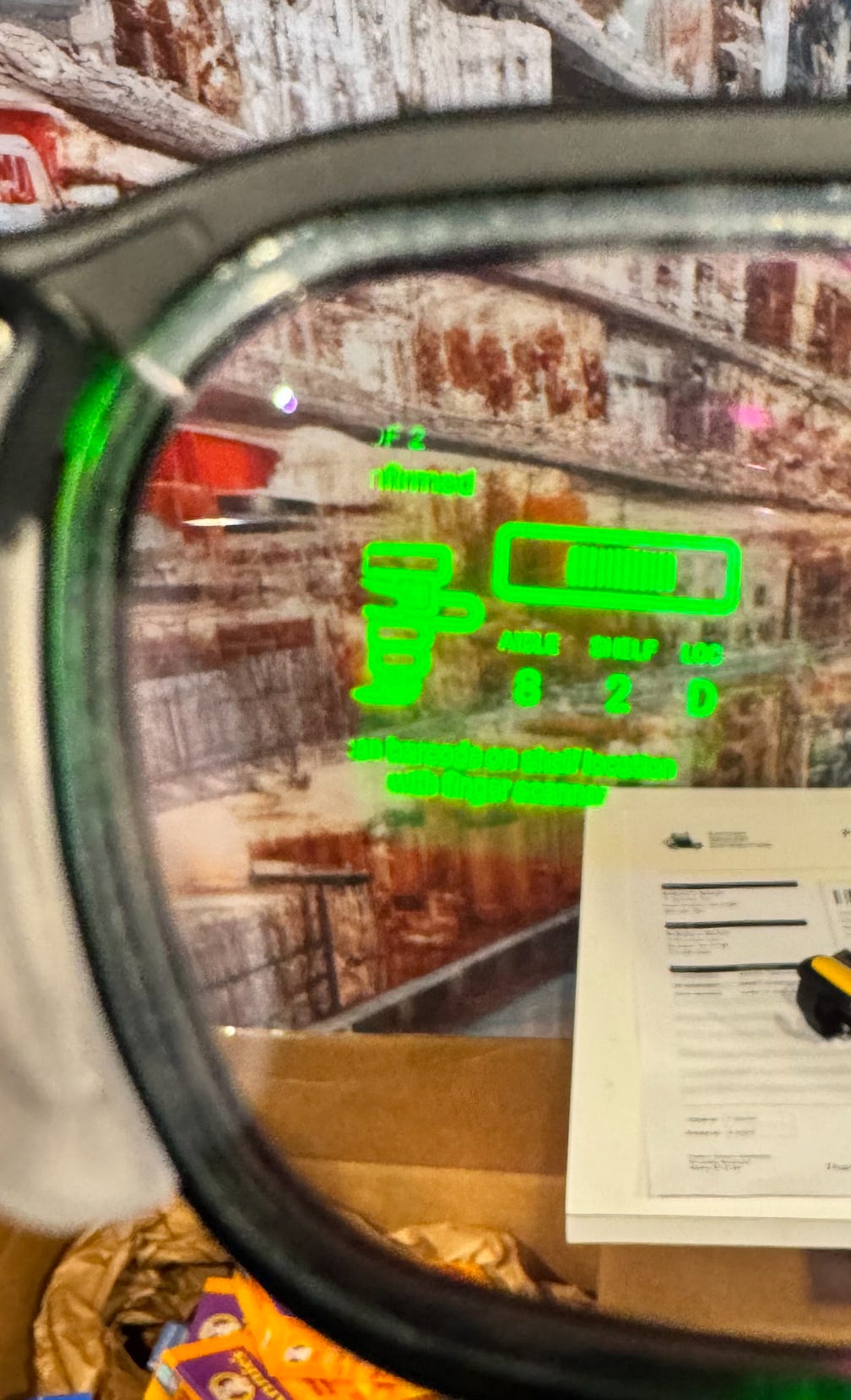
Swarovski Optik, long time makers of high end optics, had a new product that really was fun. The AX Visio are modern enhanced binoculars with a camera, screen overlays for distance and focus, etc. But they also integrate an on-board image recognition model. Via a knob you can set it to detect birds, mammals, etc. The cost almost $5000 so not for the amateur bird watcher. There are two custom slots on the knob which allow developers to add their own models (uh oh, law enforcement anyone). Definitely had a blade runner feel, again.
Batteries and EV/Cars/Transport
If there is one thing you can walk away from CES believing it is that the future of everything is batteries, and if not batteries than the sun, or the sun plus batteries. I definitely want to commend the marketing person who figured out that you could rename a battery to be a “power generator” because boy that is really confusing but also brilliant.
This seemed to be the year where the new companies on the block: uGreen, Jackery, and so on (they aren’t totally new but relatively) are “normalizing” using them as backup power for the home. This is pretty wild for me to see as I remember ages ago when battery backups for data centers first showed up at CES and they would tell you the reason they are here is because they do a huge business in urban areas around the world with unreliable power (like west Africa). So here we are in 2024 and the story everyone is telling in the booth is about living in Houston and needing a battery backup. Certainly Tesla’s power wall had something to do and in suburbs I’ve seen these installed more than I would have thought.
There’s still a bit too much testosterone marketing these batteries and solar systems and a lot of nonsense marketing that seems to run right up against the edge when it comes to promises for watts, charge time, output, etc. Still the booths are fun and definitely some wild systems. I wish there was a bit more standardization for the home because wiring something into the main panel that you know has a finite lifetime (lithium batteries) sounds like an expensive commit. But for us normal people, I definitely keep one of these larger ones charged for blackouts. I can’t connect the refrigerator but can definitely charge phone and laptop and start a car if needed.
Of course the biggest user of batteries would be cars and as has become the norm, CES is about 20% “car show”. I still believe there’s a mismatch between the auto industry and the consumer electronics. In the world of the Detroit auto show showing off concept cars is normal and the fun part. I think at CES showing off entirely conceptual cars (like the Hyundai Iqonic with Mobis e-Corner that enables the car to drive sideways—they’ve been showing variants of this for 5 years now).
At the other end are entirely new platforms trying to sell cars as though they are consumer electronics but that requires a whole level of regulatory oversight. In that sense this is a bit like healthcare. One example which I loved was a concept that is somewhat larger than a US “NEV” but super practical. I would love if we would all drive things like this but until there are not F-150s on the road it would be terrifying.
The really interesting EV category is industrial. There were some GIANT electric heavy equipment trucks. CATERPILLAR is basically making a Dewalt-like bet on a modular battery to work across all their heavy equipment trucks. They showed an underground mining truck! Nuts. They even have an onsite generator which charges their giant batteries.
Besides CAT there were all sorts of lawnmowers, landscaping tools, and other earthmovers. It really does seem like these are moving up the food chain and becoming commercially viable. At everyone people who seemed to know what they were talking about were grumbling but it is tough to know if this is really a problem or “range anxiety” as expressed by earth moving professionals. The booth staff talk a lot about how equipment like this isn’t used for 8-10 continuous hours and there is a lot of downtime so they don’t need a full 8 hours plus the CAT ones at least are swappable. I think anyone who has watched construction knows this.
My favorite EV after the tiny one was at the other extreme, this Bollinger. They would not disclose the armor or protection.
This is a super cool Honda that will probably never ship.
Finally with respect to autos, there were dozens of component makers from Lidar to chargers. I don’t know if CES is the place these decisions are made but there are a lot of companies chasing this world. Also, EV chargers are getting huge in their capacity as they prepare for cargo trucks. Gonna need a bigger panel for sure!
Its a MagSafe and Qi2 world
I wanted to end with a quick word about mobile phones and bring it back to the supply chain.
Some attend the show for work and then when they walk around they stop working and think about the floor as a really big BestBuy and try to find stuff to buy that solves their immediate problem. It used to be stereo gear, then laptops, then cameras, often it is TVs, and more recently it is stuff for phones. Phones are a bit different because the phones themselves don’t make a big splash at the show. Samsung had almost not demo station. Apple of course is not at the show. Instead the show is filled with vast numbers of accessories, mostly cables, charges, stands, and cases. It can get dizzying. Then frustrating.
It is frustrating because you quickly realize you see so many of the same thing. Often with different labels. That’s the Shenzhen supply chain at work. Many products from cables to chargers come from a small number of factories, especially the components, and are packaged up for retail by another set of makers. Very few who sell these accessories design and build them on their own completely (like Anker does). What you can learn by walking around is which brands are really just brands versus makers.
An example I found was this 3-in-1 MagSafe charger. I see the add on instagram all the time. I noticed it was all over the show floor. Then I looked on Amazon where there are a half dozen sellers at marginally different prices (be sure to check delivery date). On IG this one advertises for $90 with s recent price change. On Amazon I bought 2 for $20 recently.
The supply chain works. You just have to be an intelligent consumer. It is either annoying or an amazing thing. The world needs all of these price points because that is what creates the economics for all the other stuff to happen.
This year was definitely the year of MagSafe and of Qi2. The hot MagSafe item are 2-in-1 and 3-in-1 chargers for phone, watch, pods. They come in all sizes and shapes from stands to dashboard to folding. There are battery cases as well that have 2-in-1 chargers built in. Some have cables even. It is all very good for consumers. They really do differ just a little bit in form factor though not usually the electronics. I’m generally obsessed with trying these (there’s a story about my obsession with the Surface charger).
Sometimes an OEM comes along and has fun. These chargers are little Macintosh computers and even have displays that change. Pretty wild and fun.
This was not supposed to be funny but is to me. It is a 10 port USB-C charger.
That’s a Wrap
Every year the CEA (Consumer Electronics Association) sends out an email “That’s a Wrap” at the end of the show. I just got the mail. This is a wrap for me and my annual crazy hobby of visiting the show and writing this up to share. I hope you enjoyed it.
One last photo…here’s an attendee taking my picture because…they thought I was Jeff Bezos. His friend is posing with me so if that shows up on the internet know that I did not do any deals for home security it was just mistaken identity. I even told him who I was.
Such is CES. That’s a wrap. #CES2024


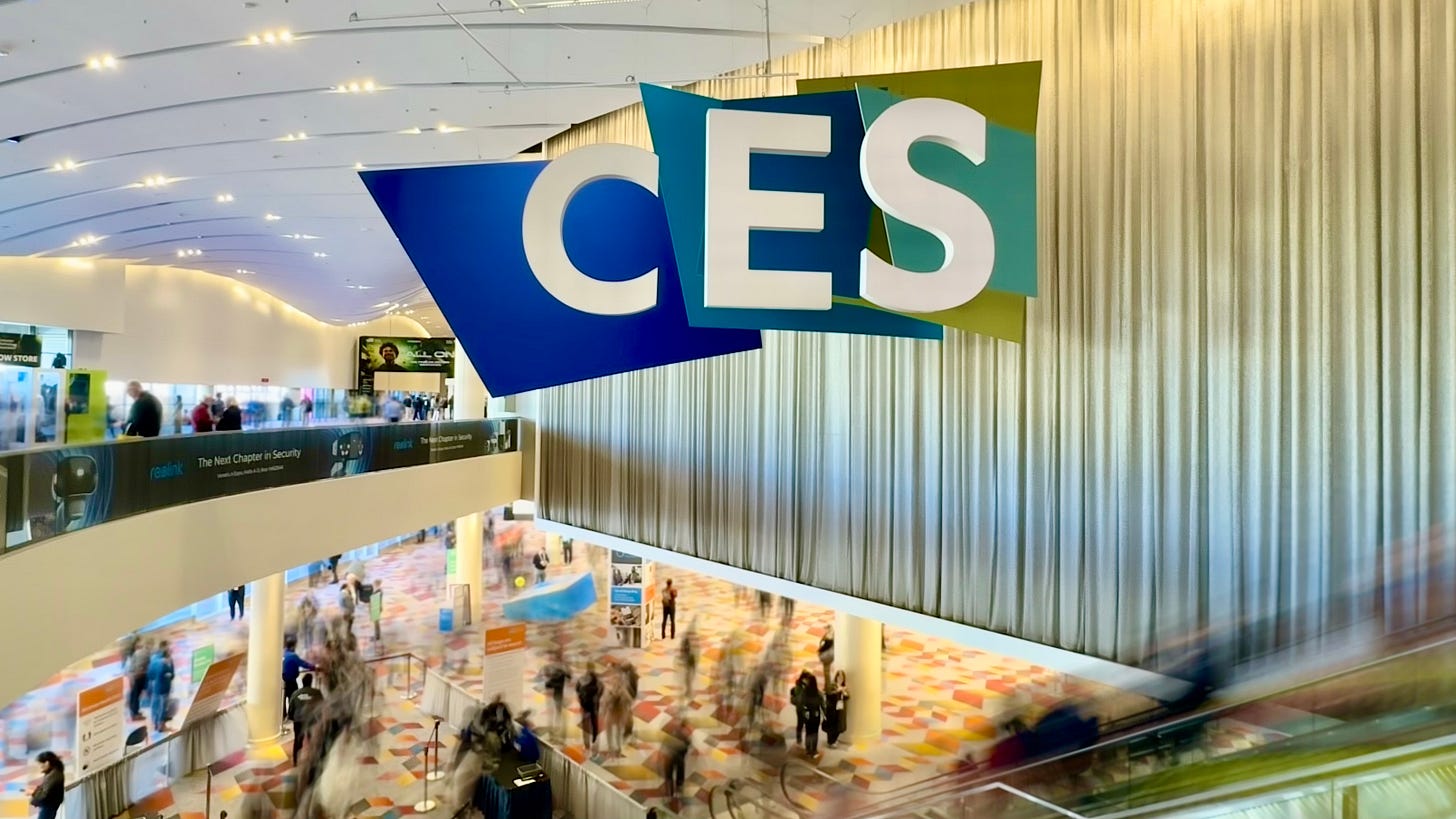
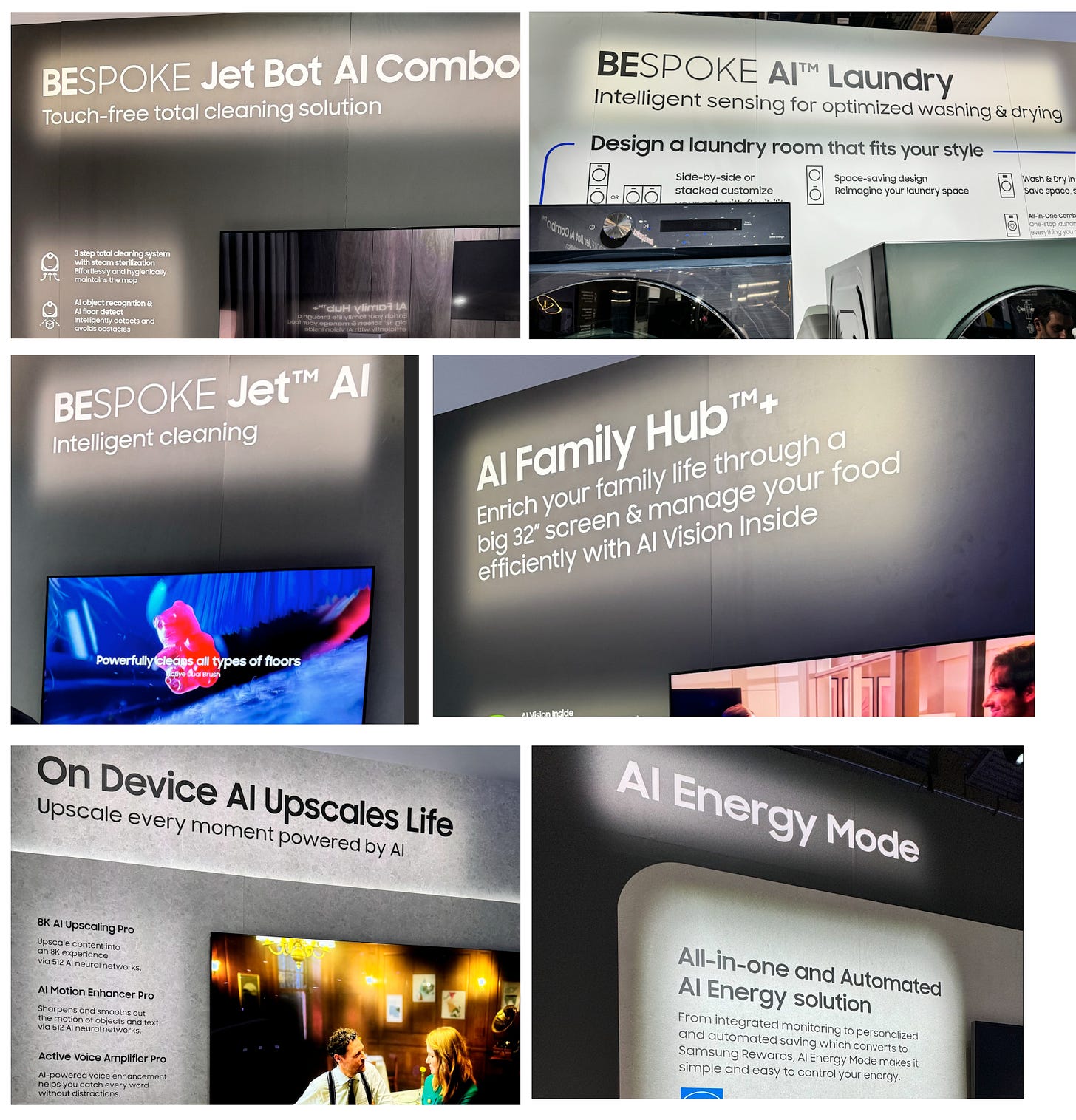

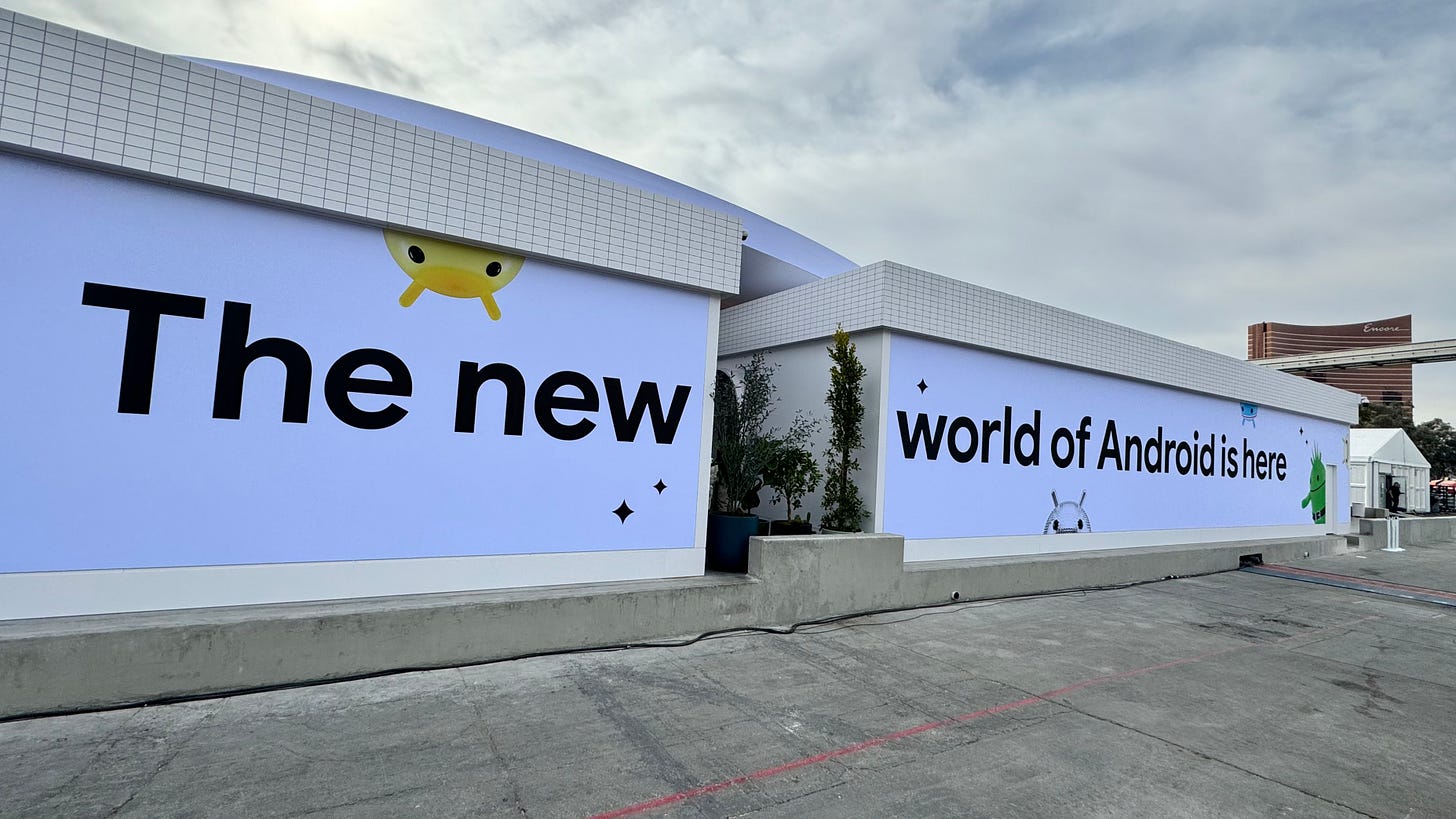
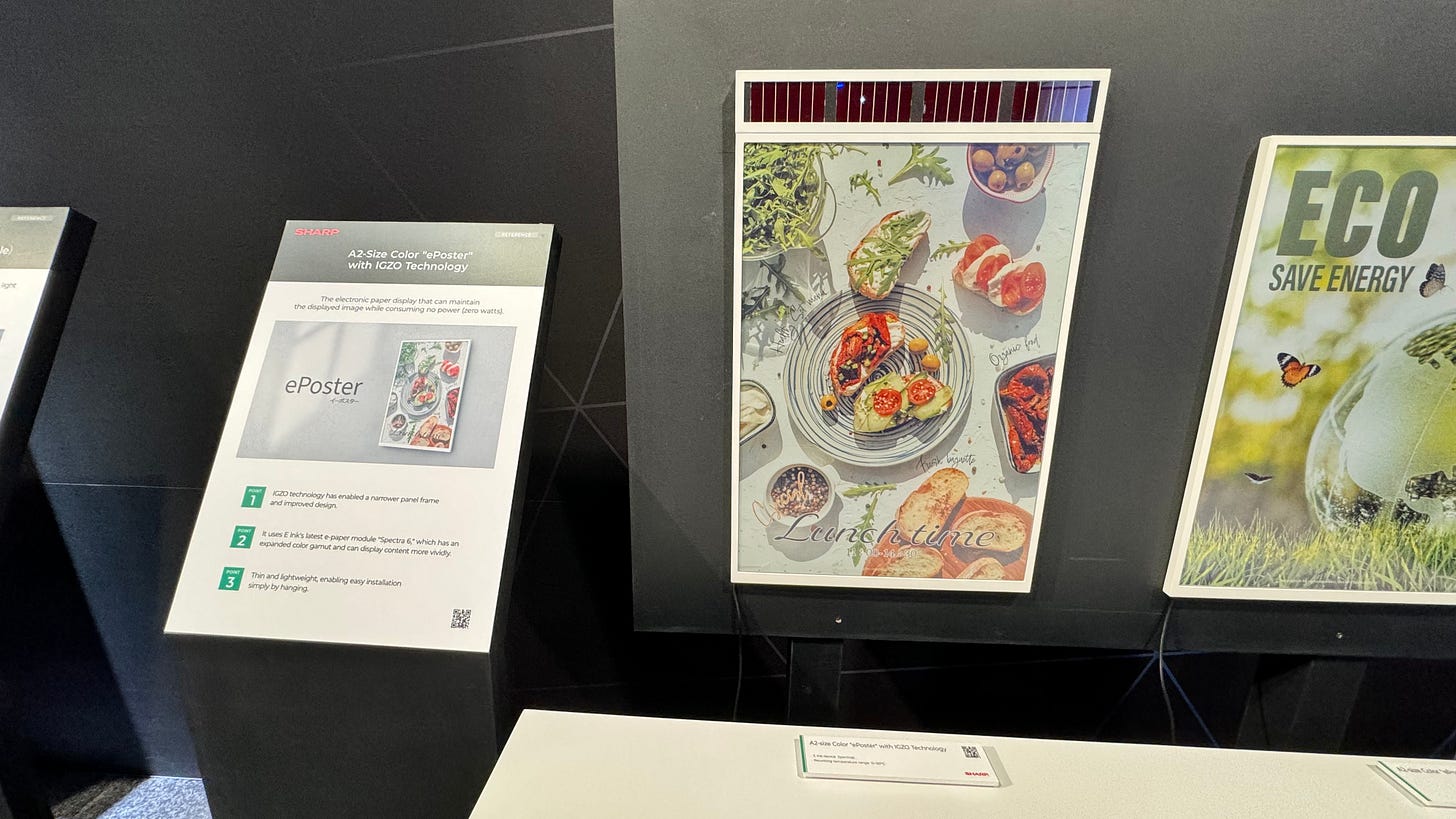
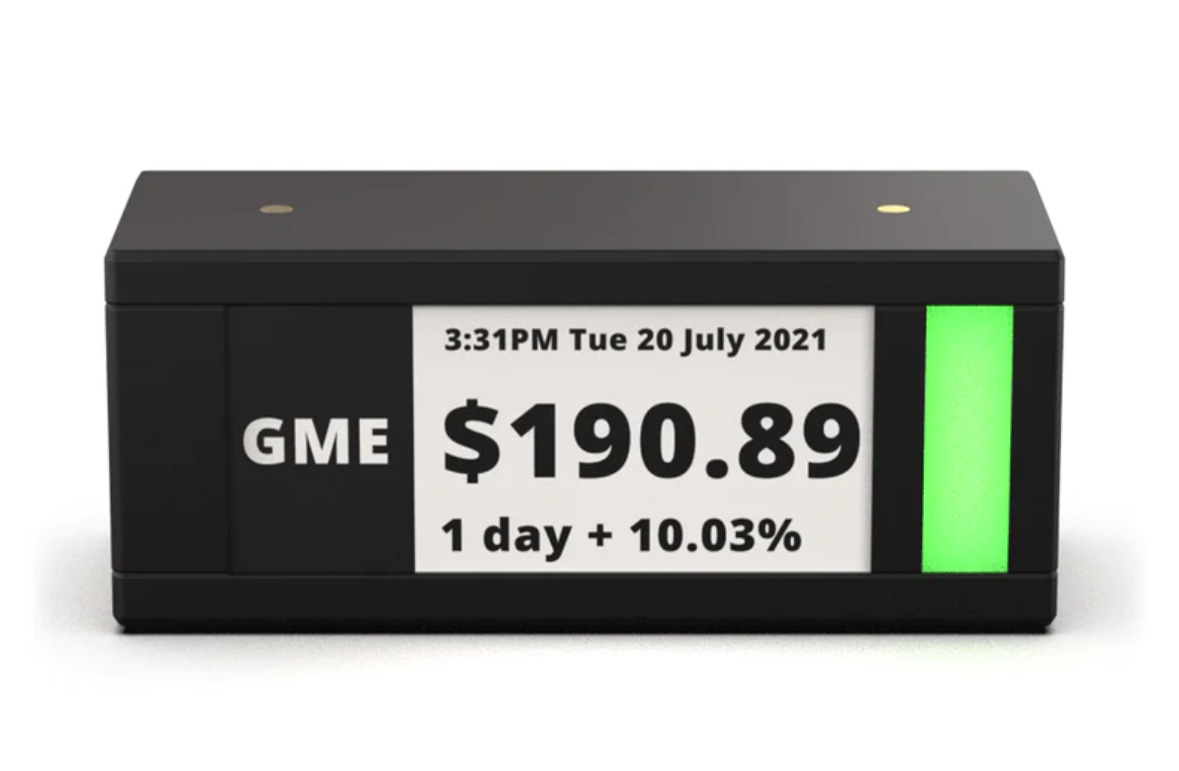

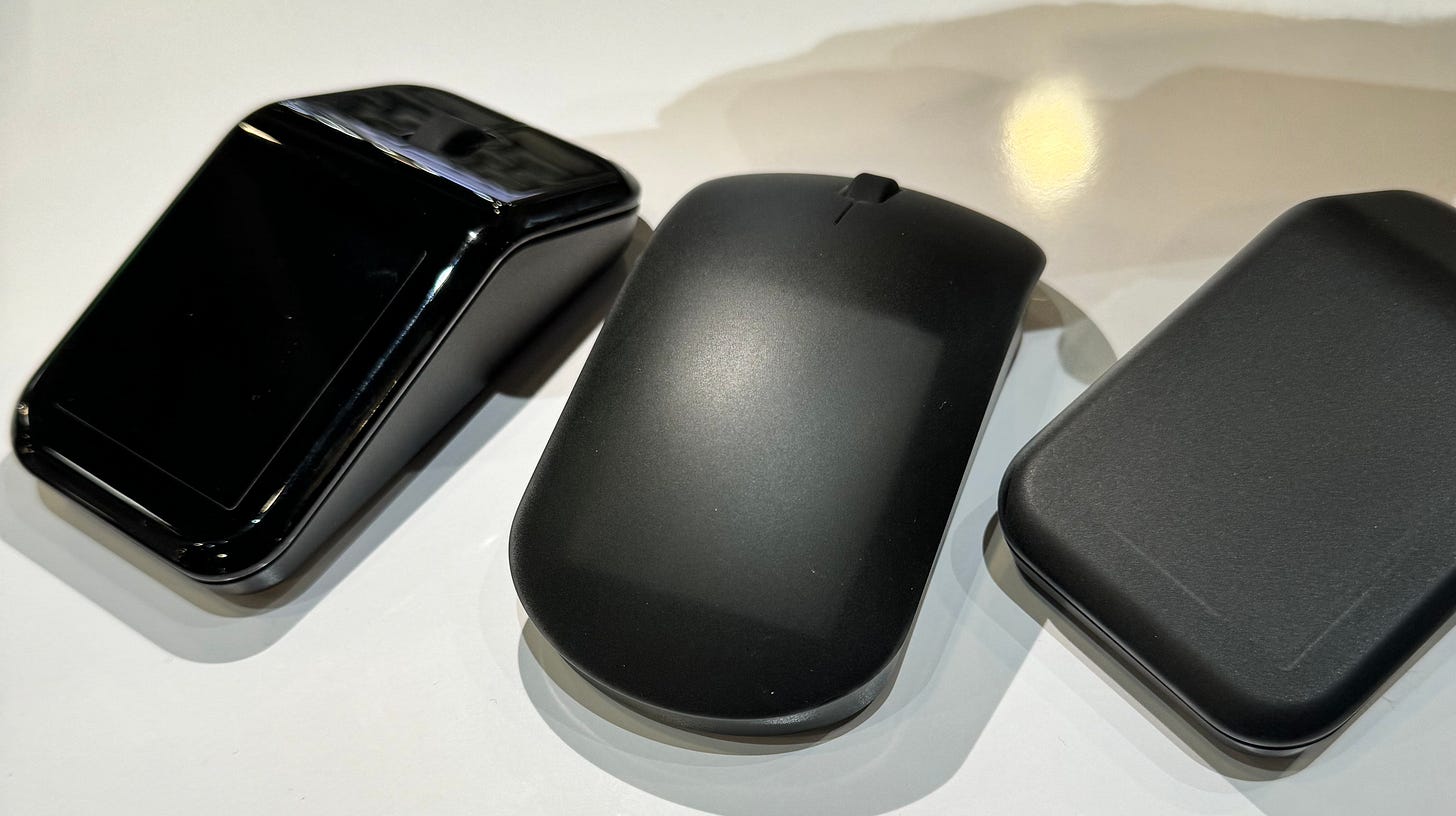
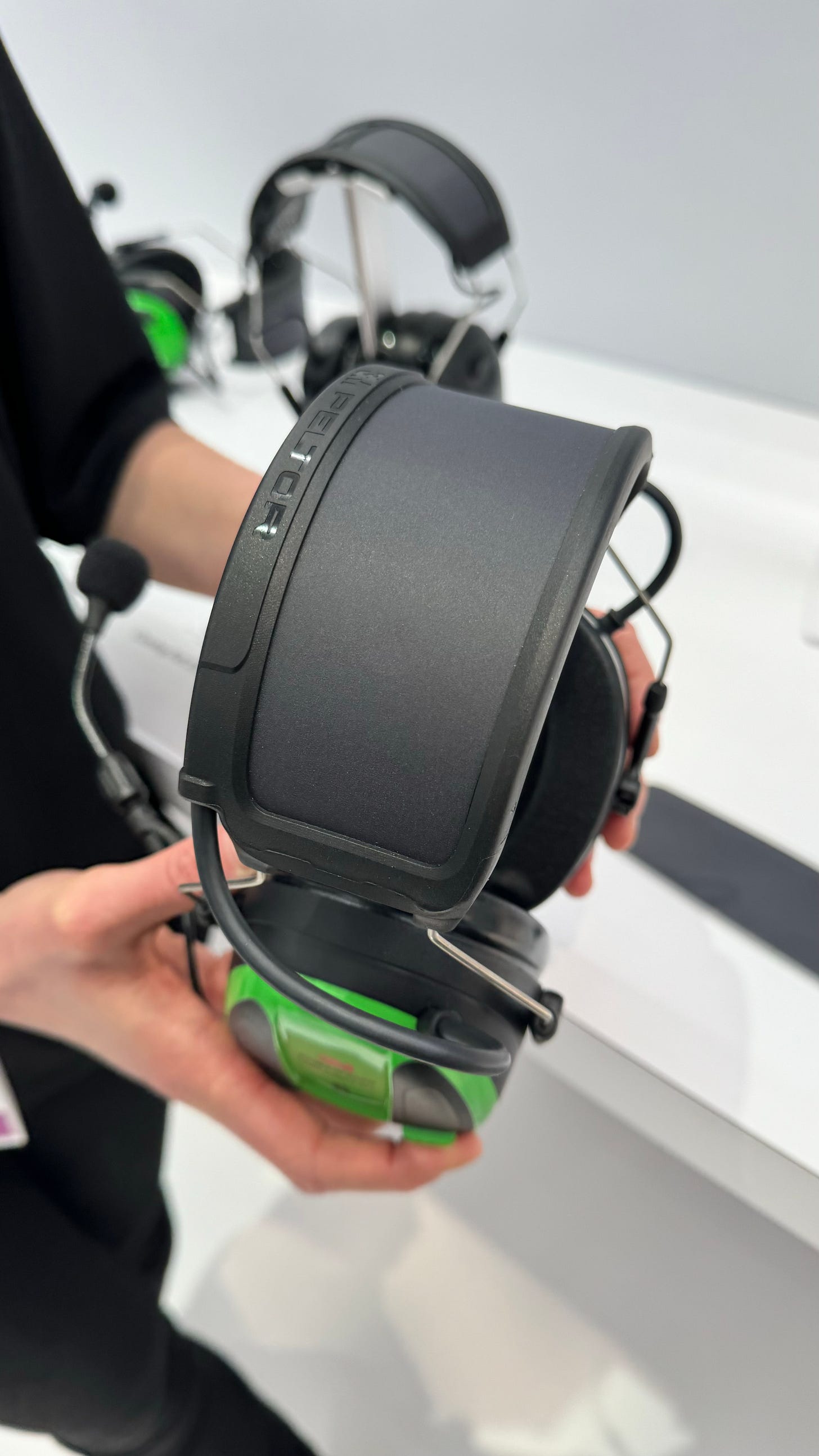
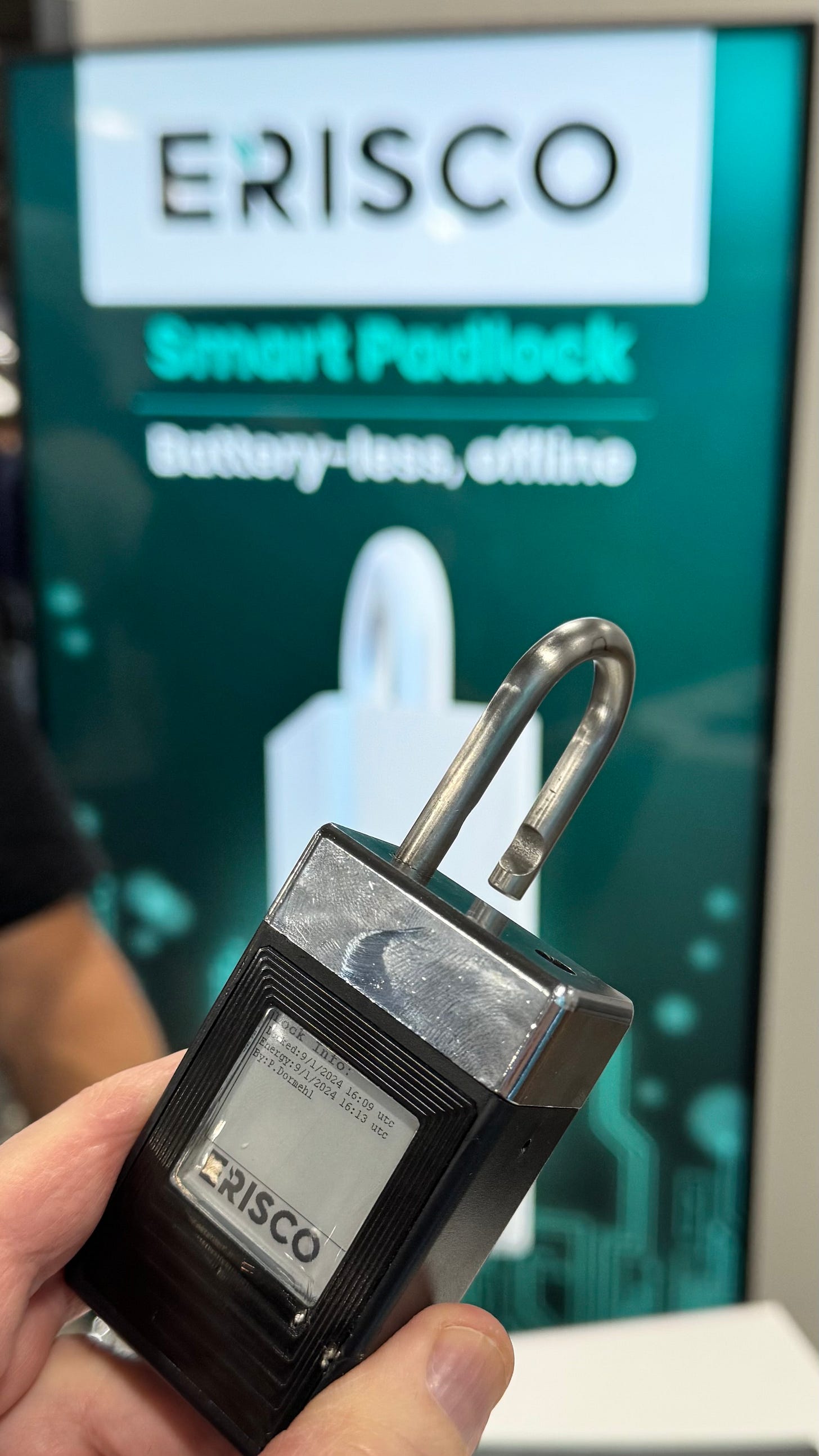
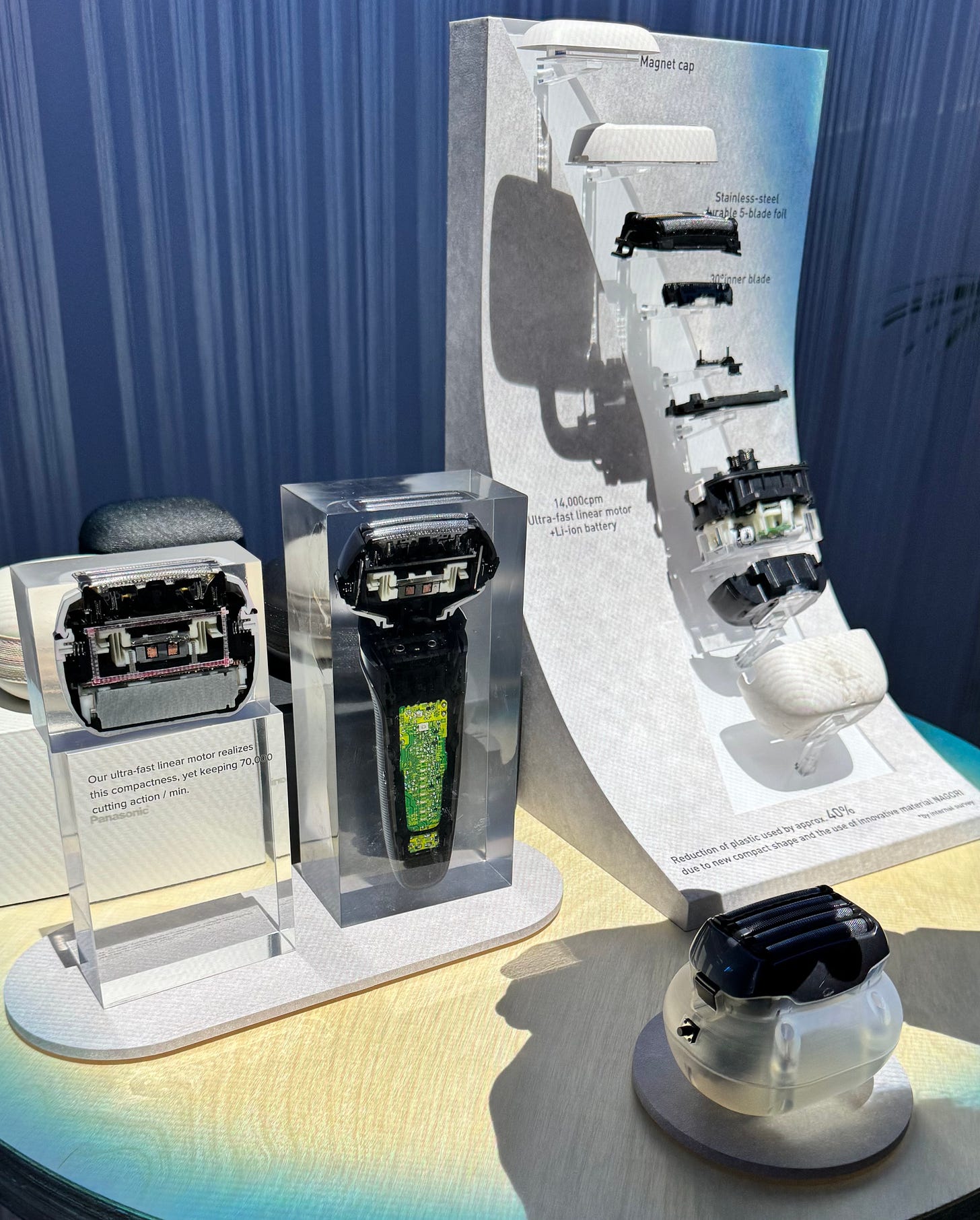
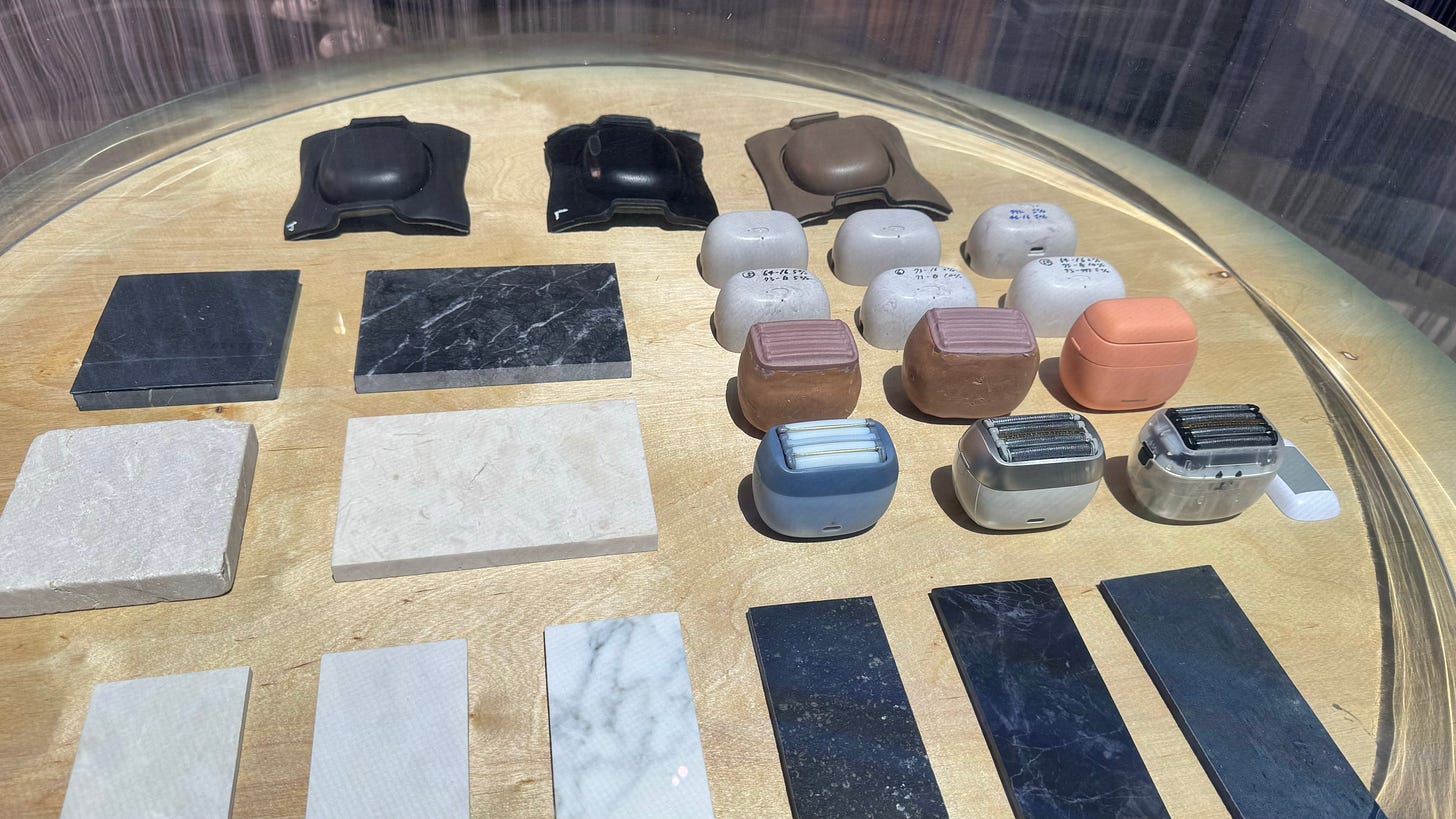
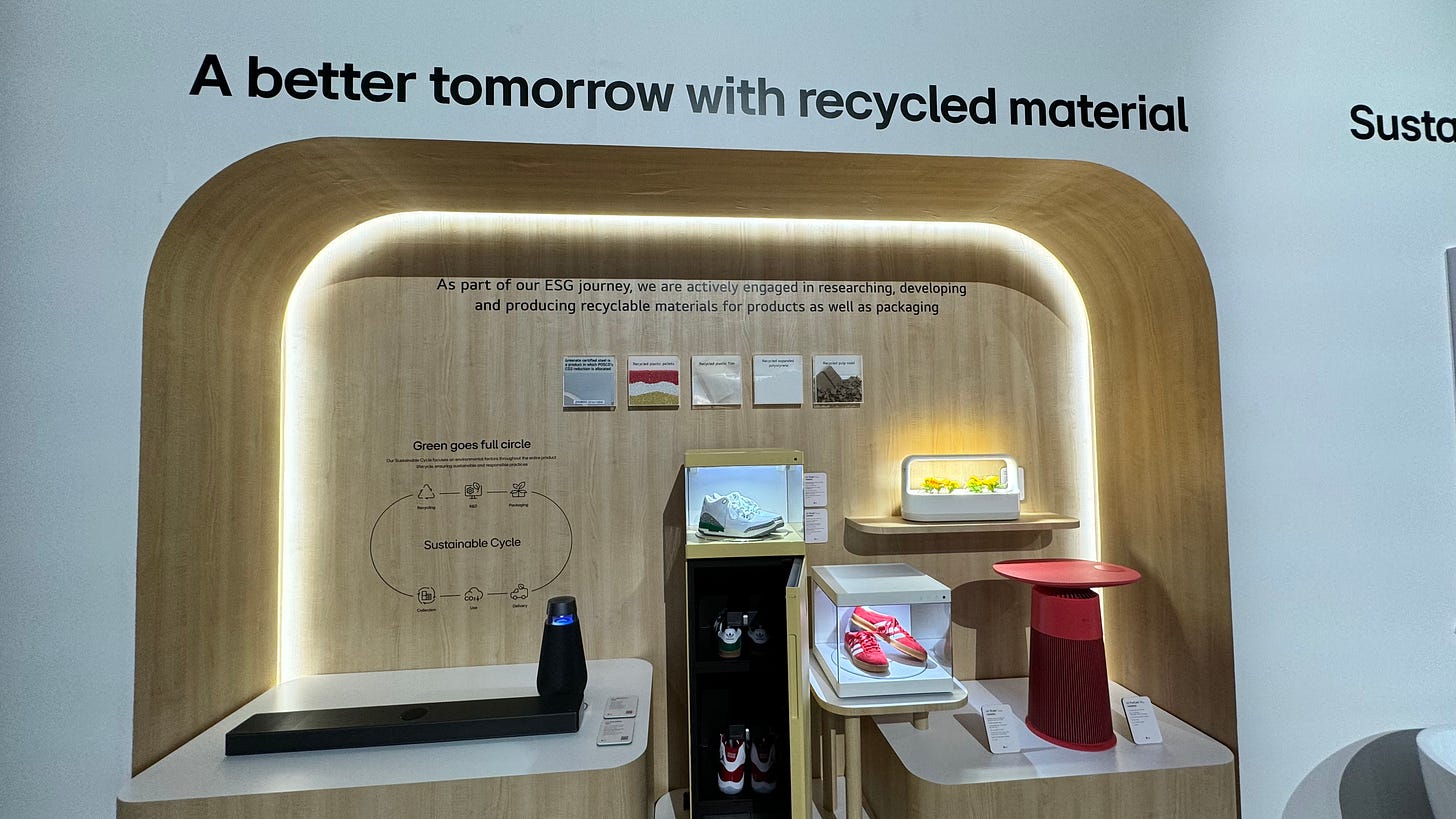
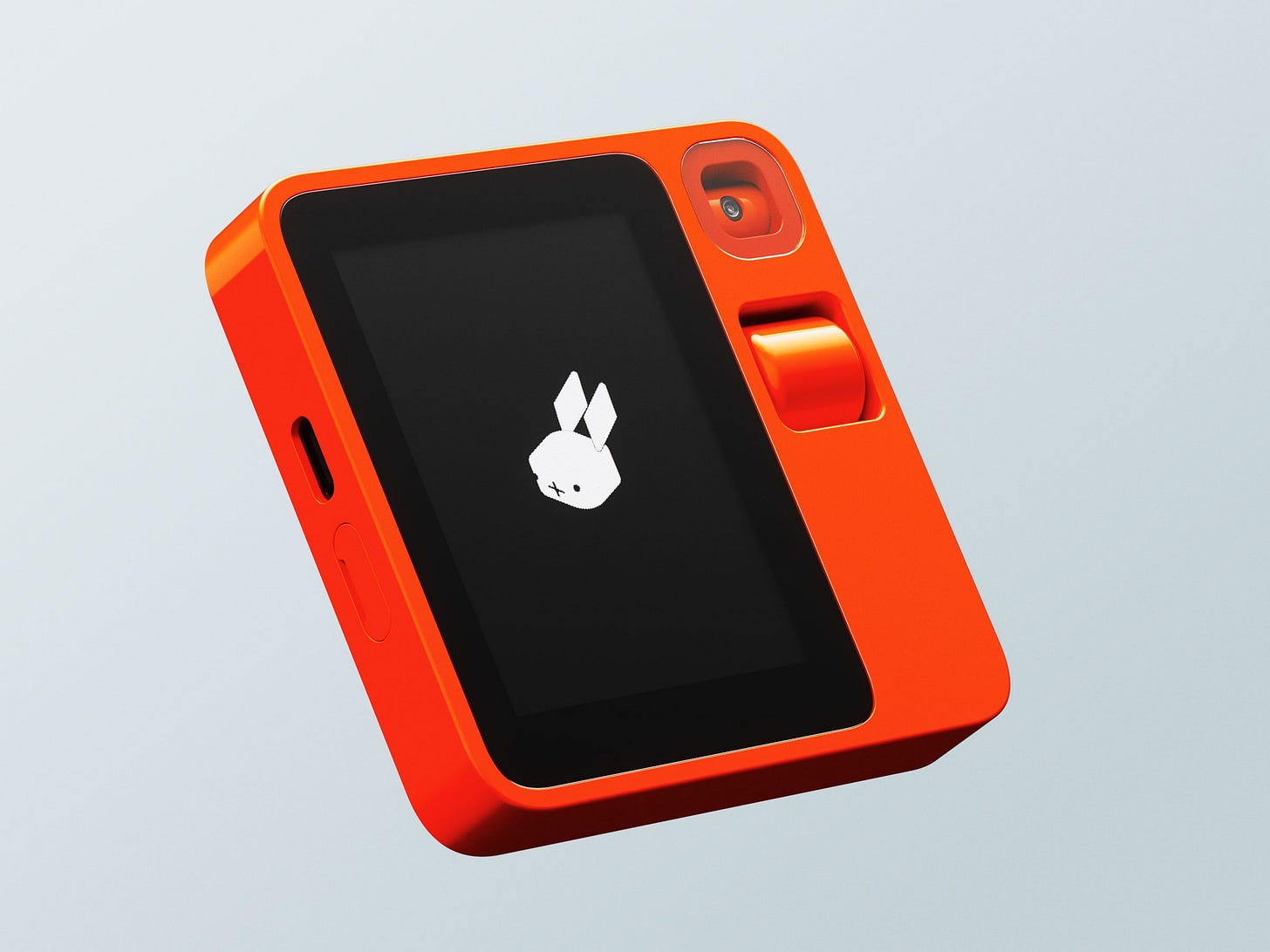
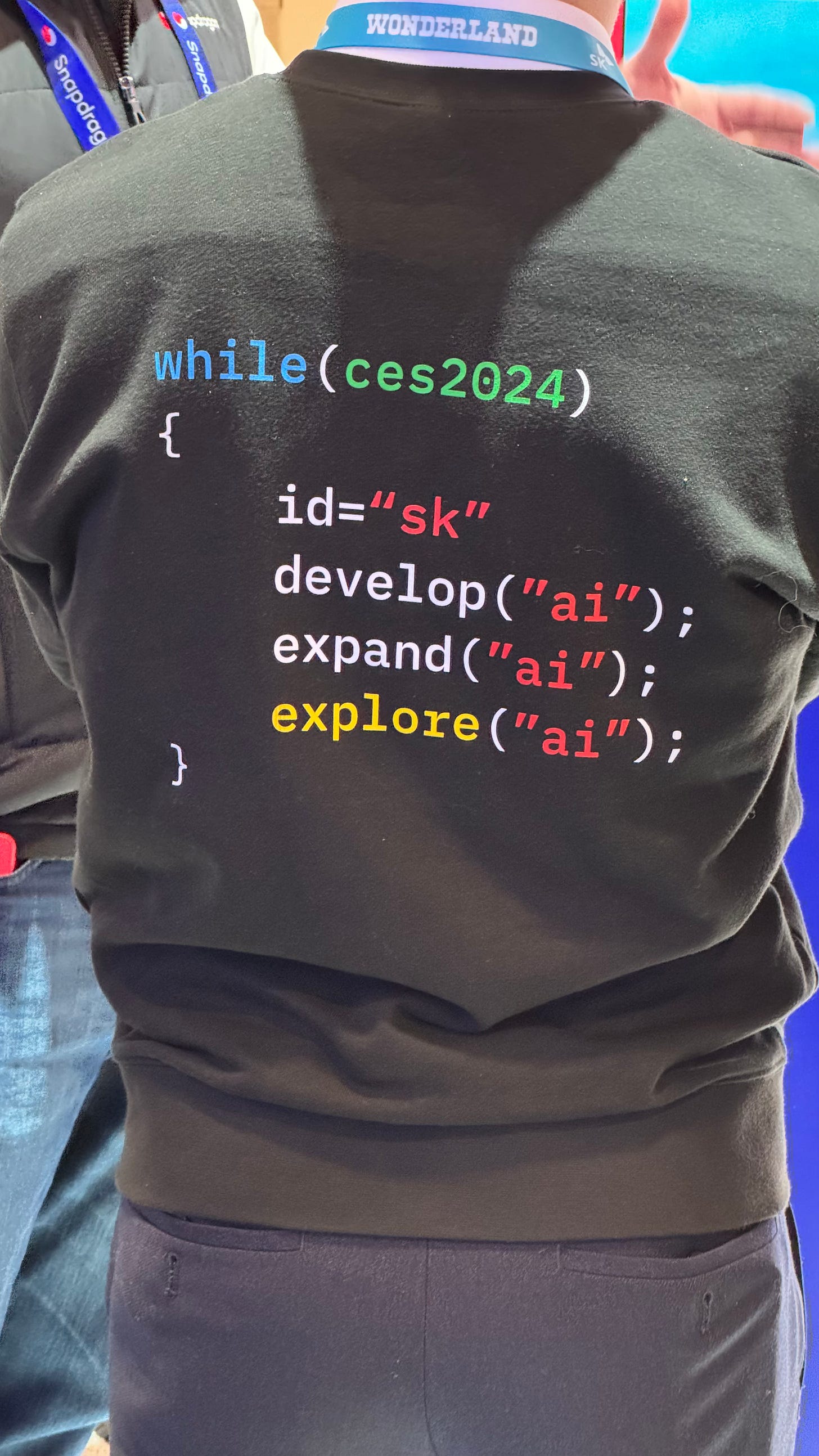

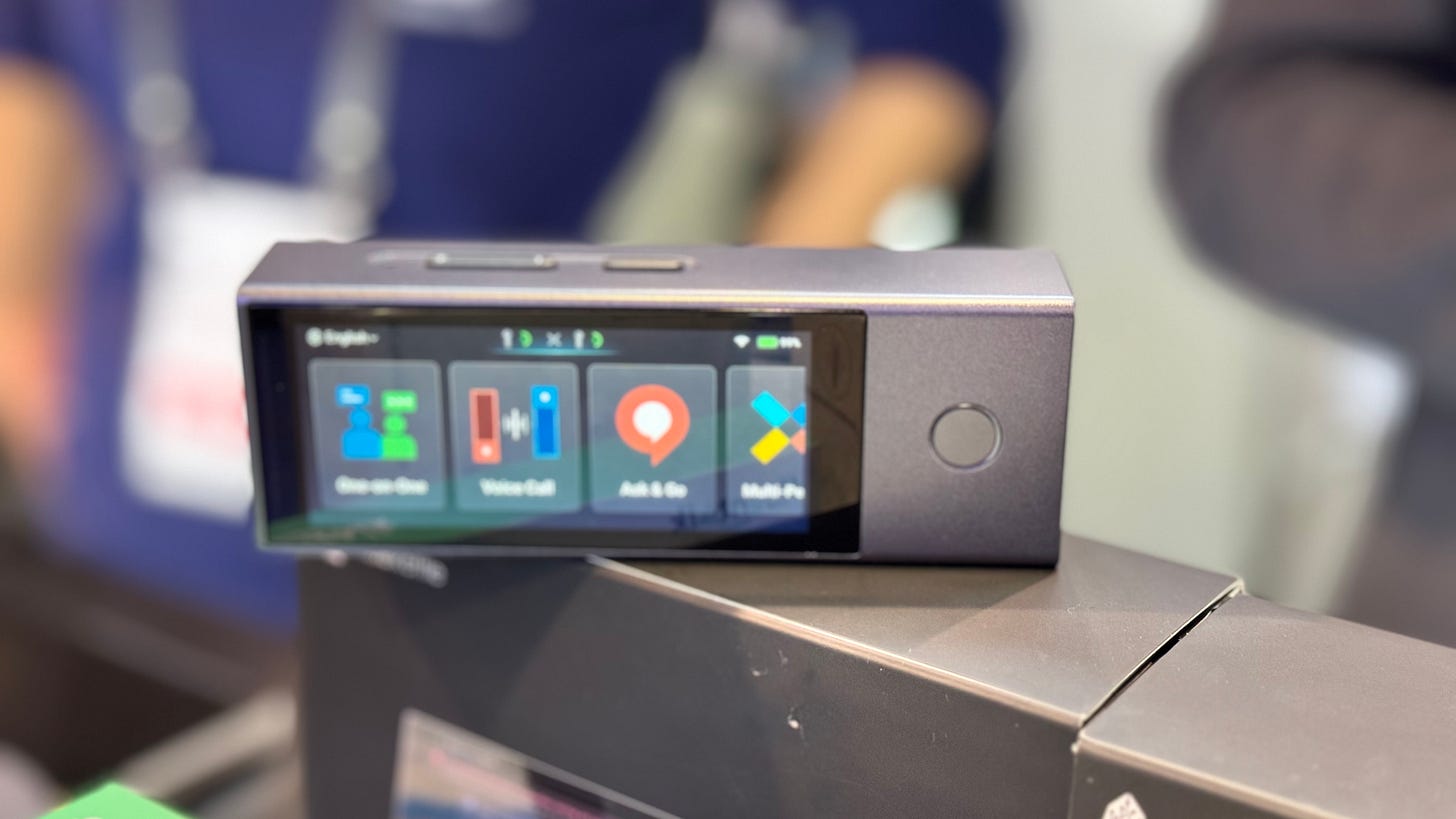


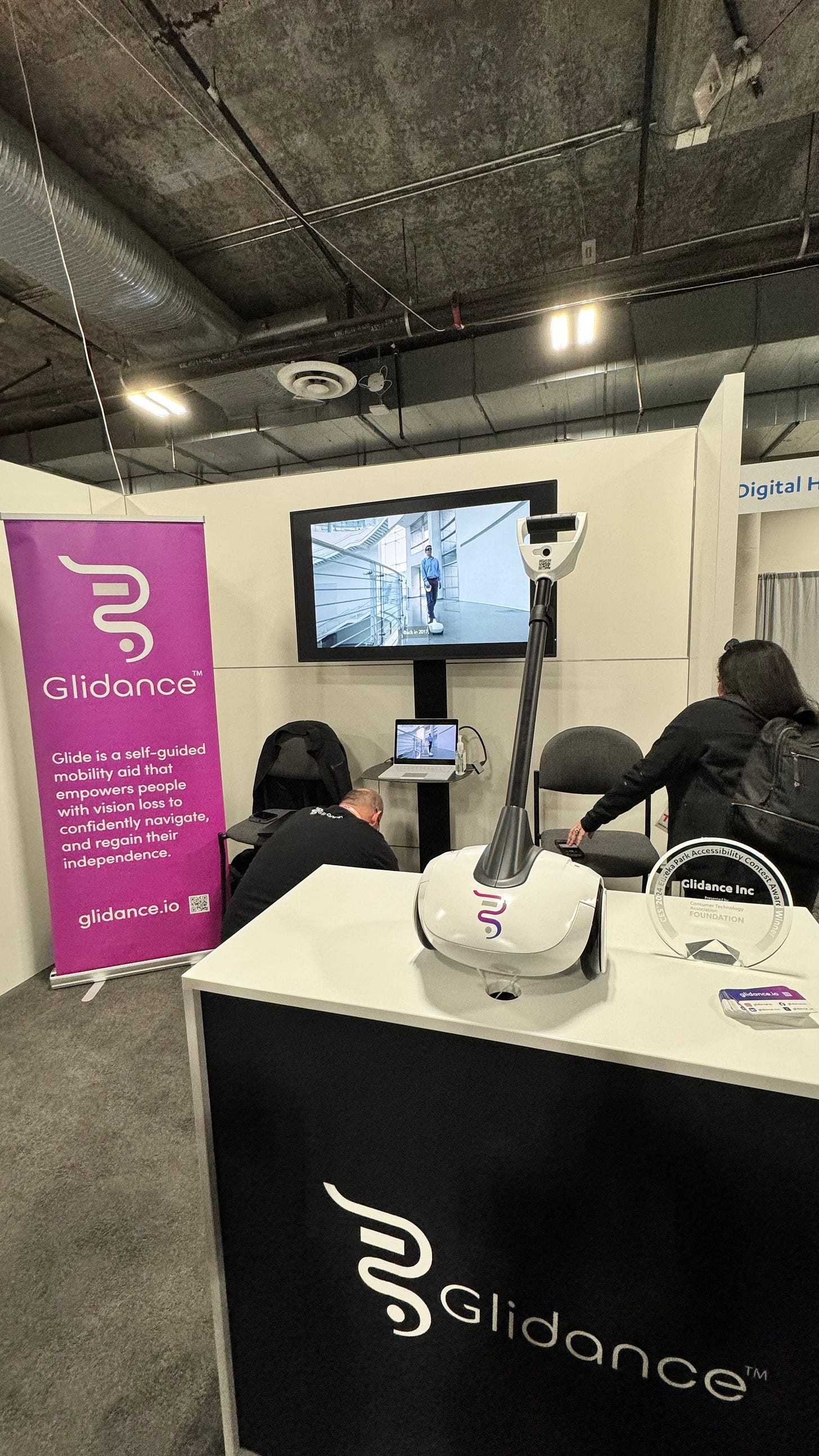
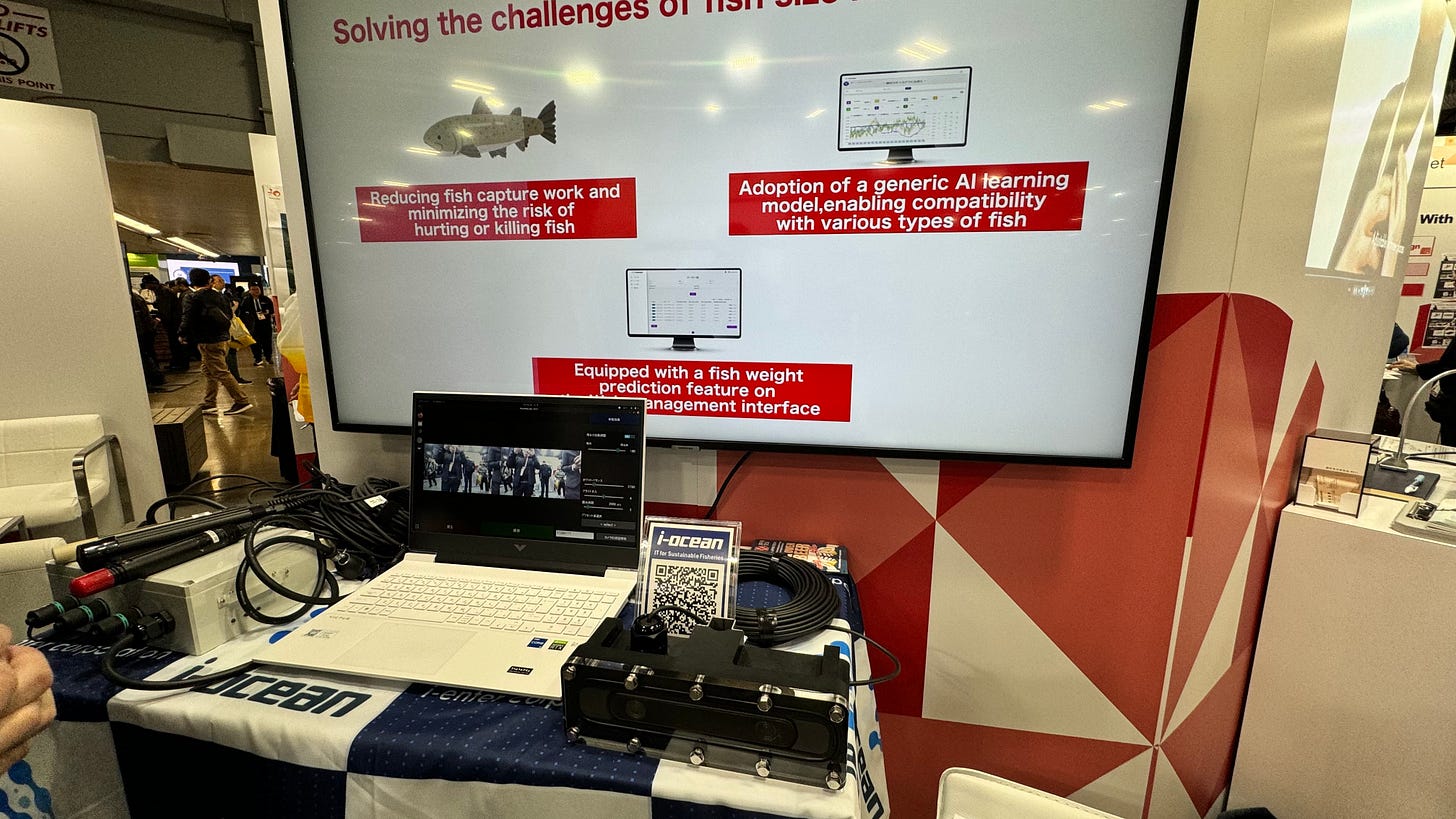


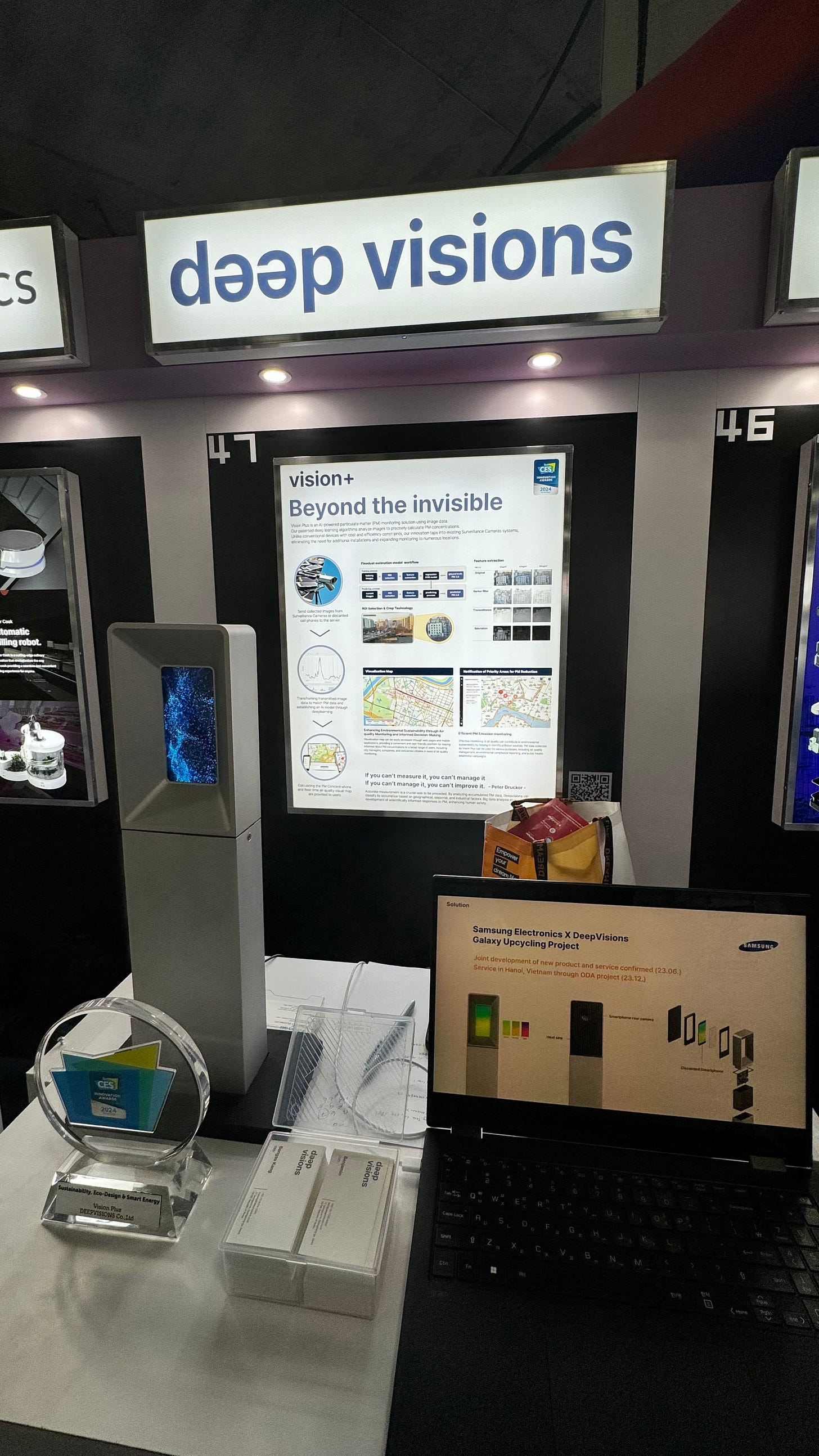
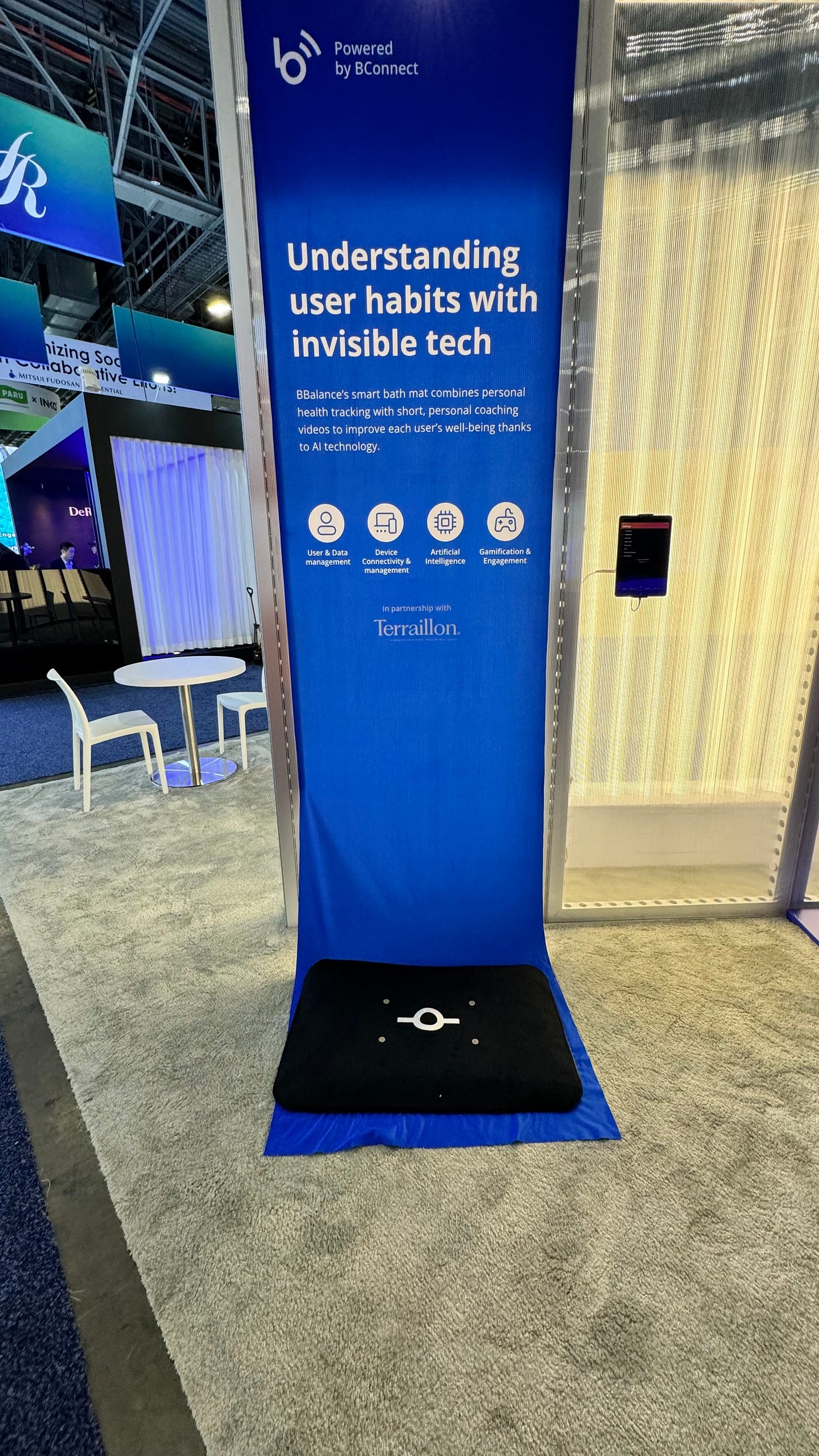
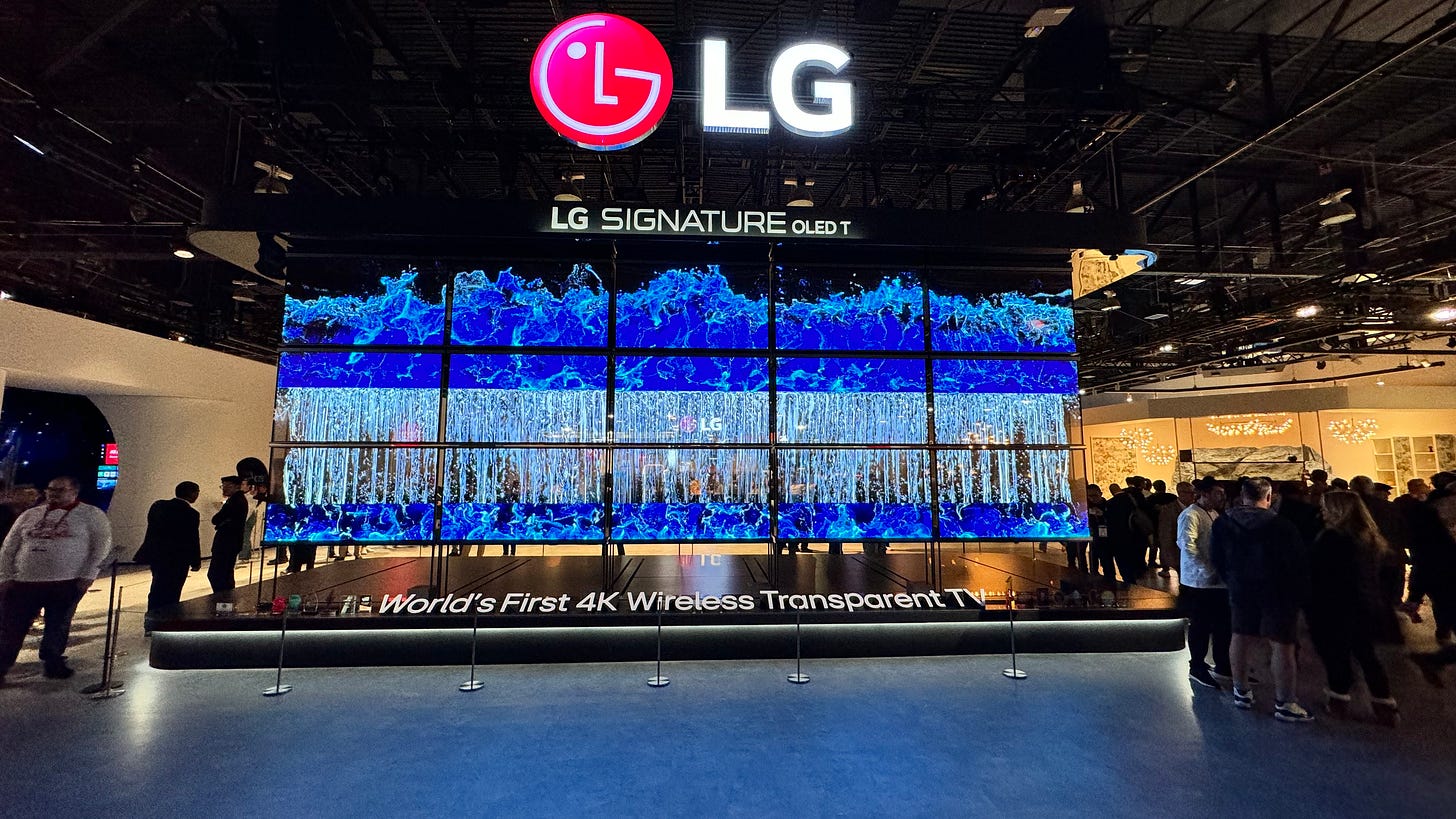
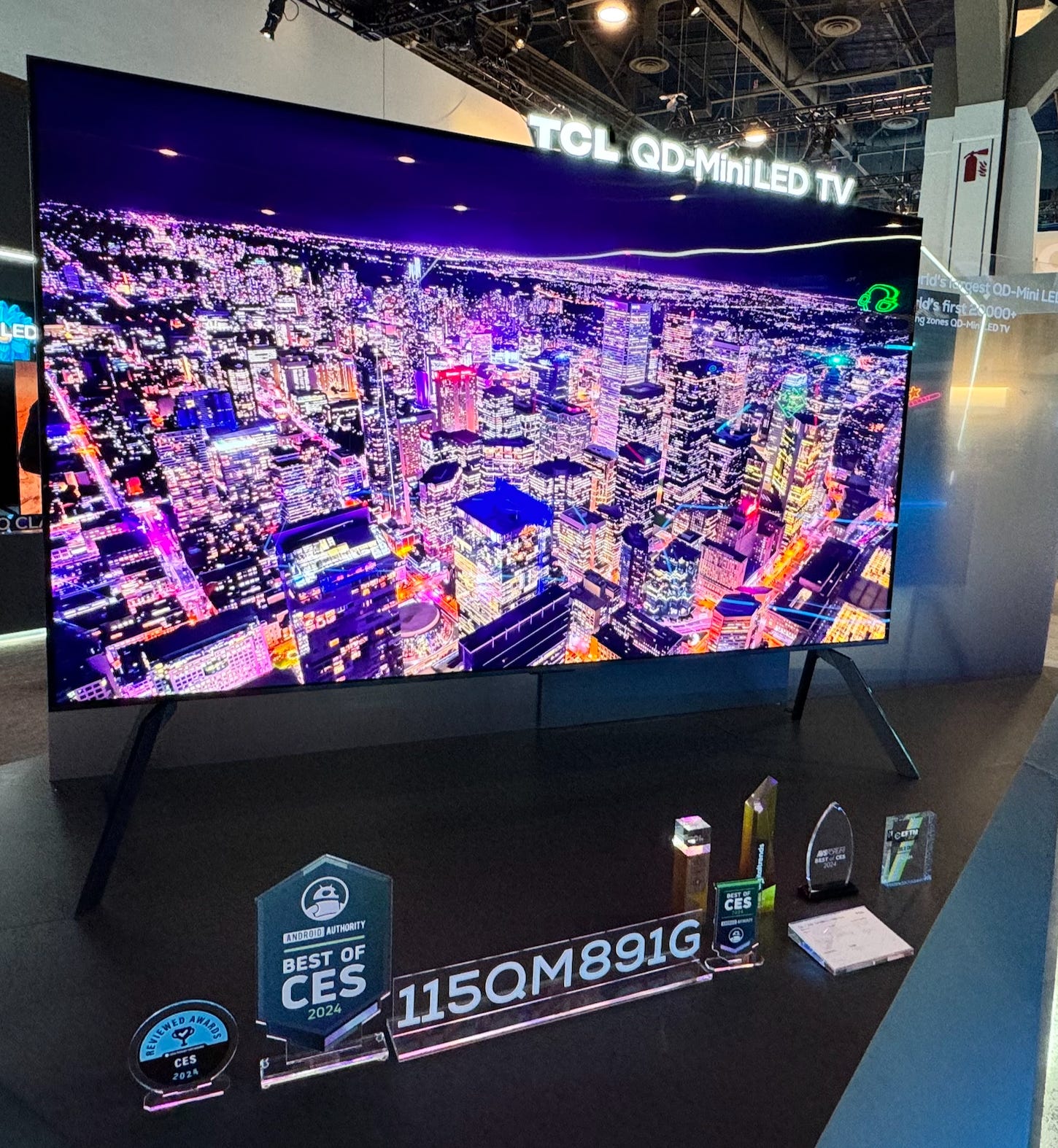







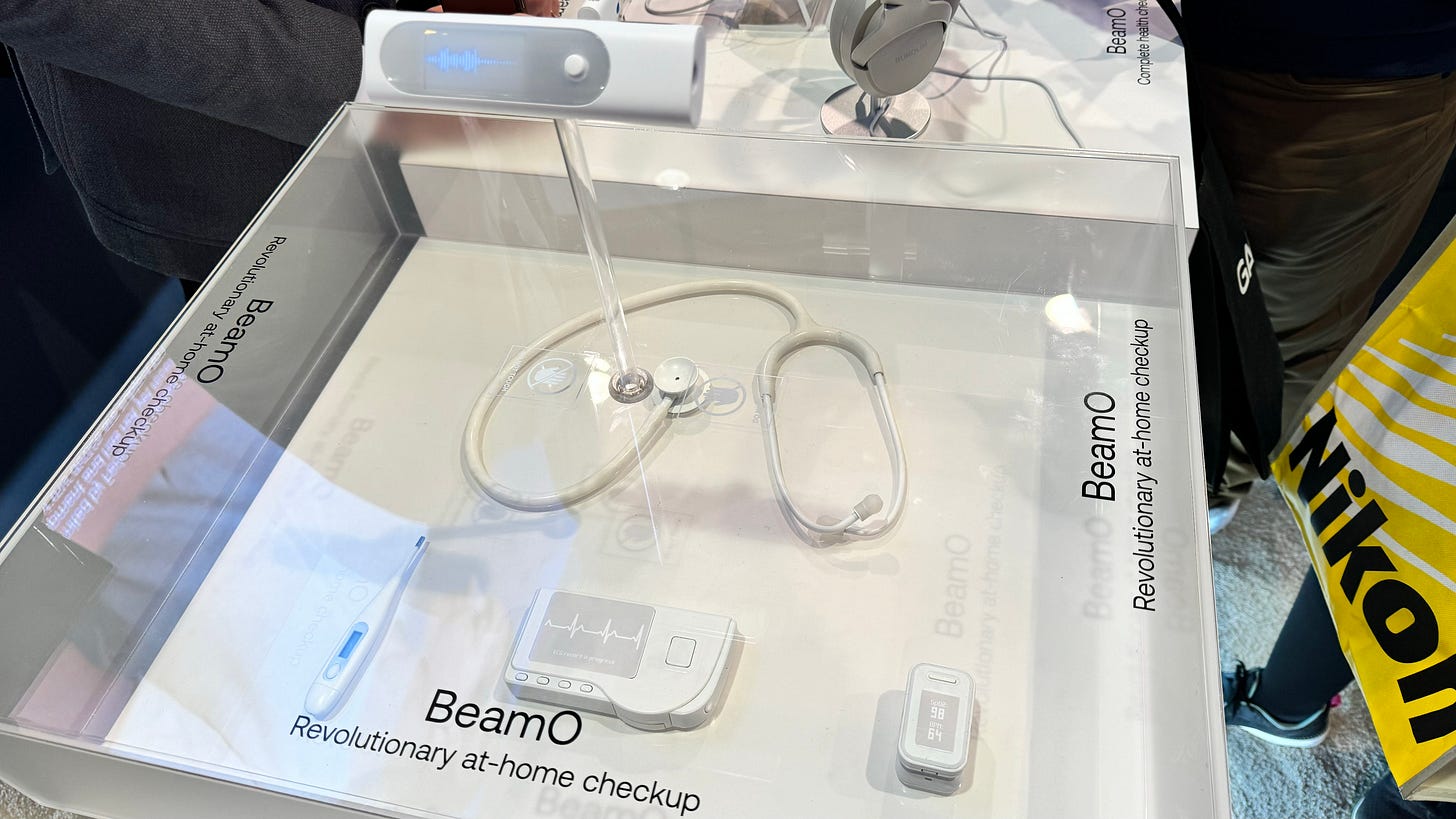



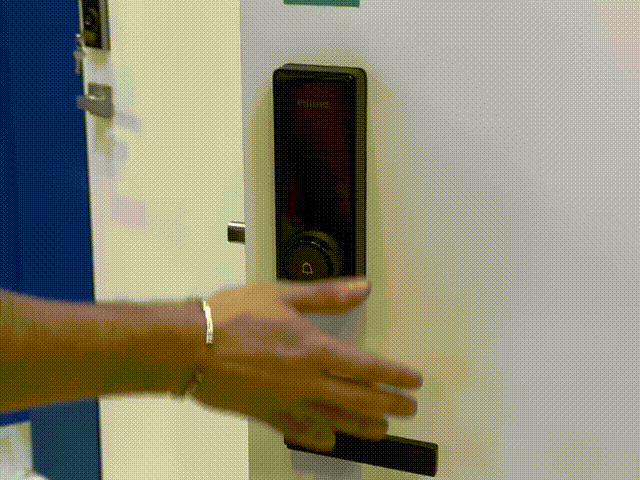
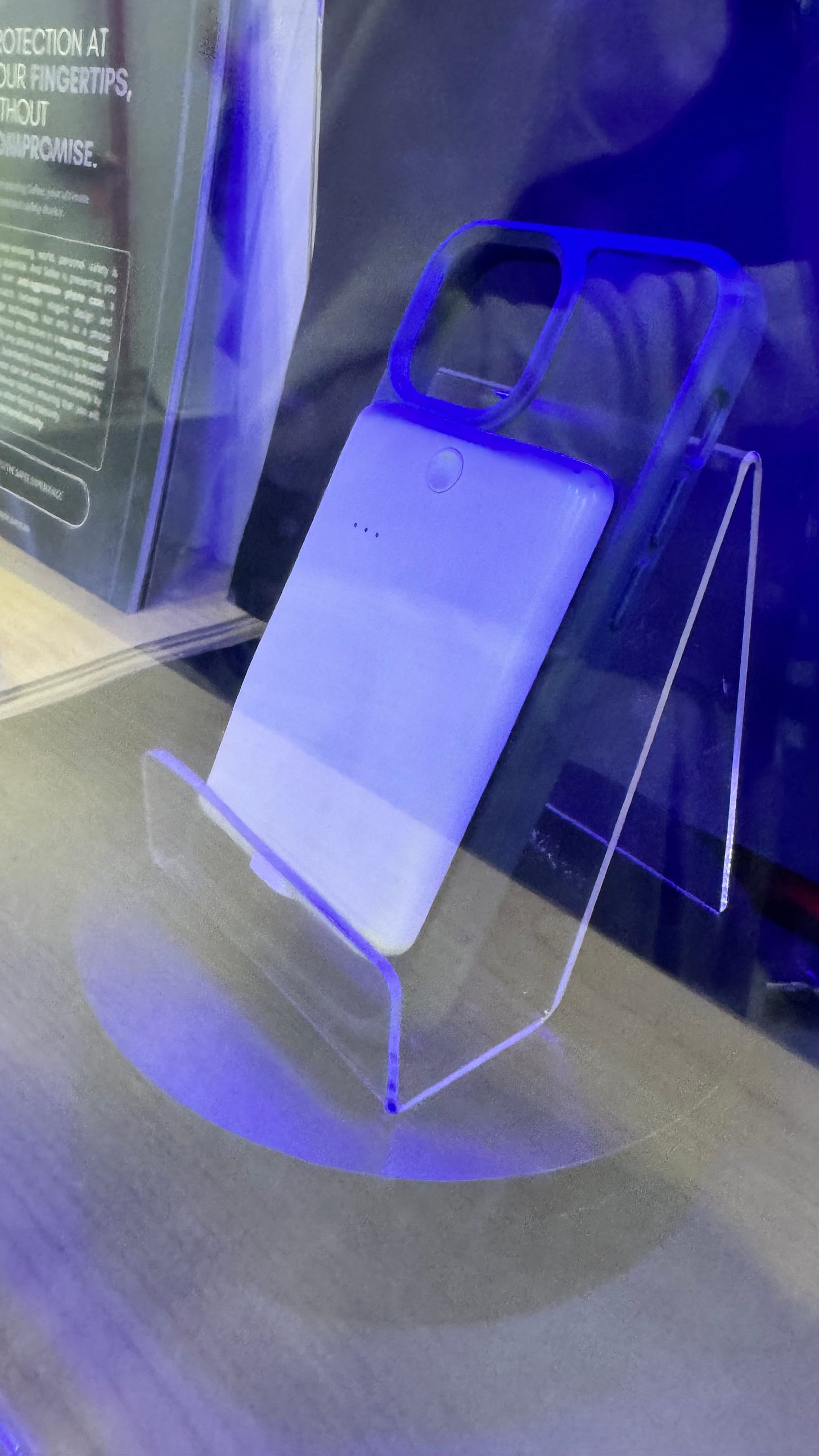


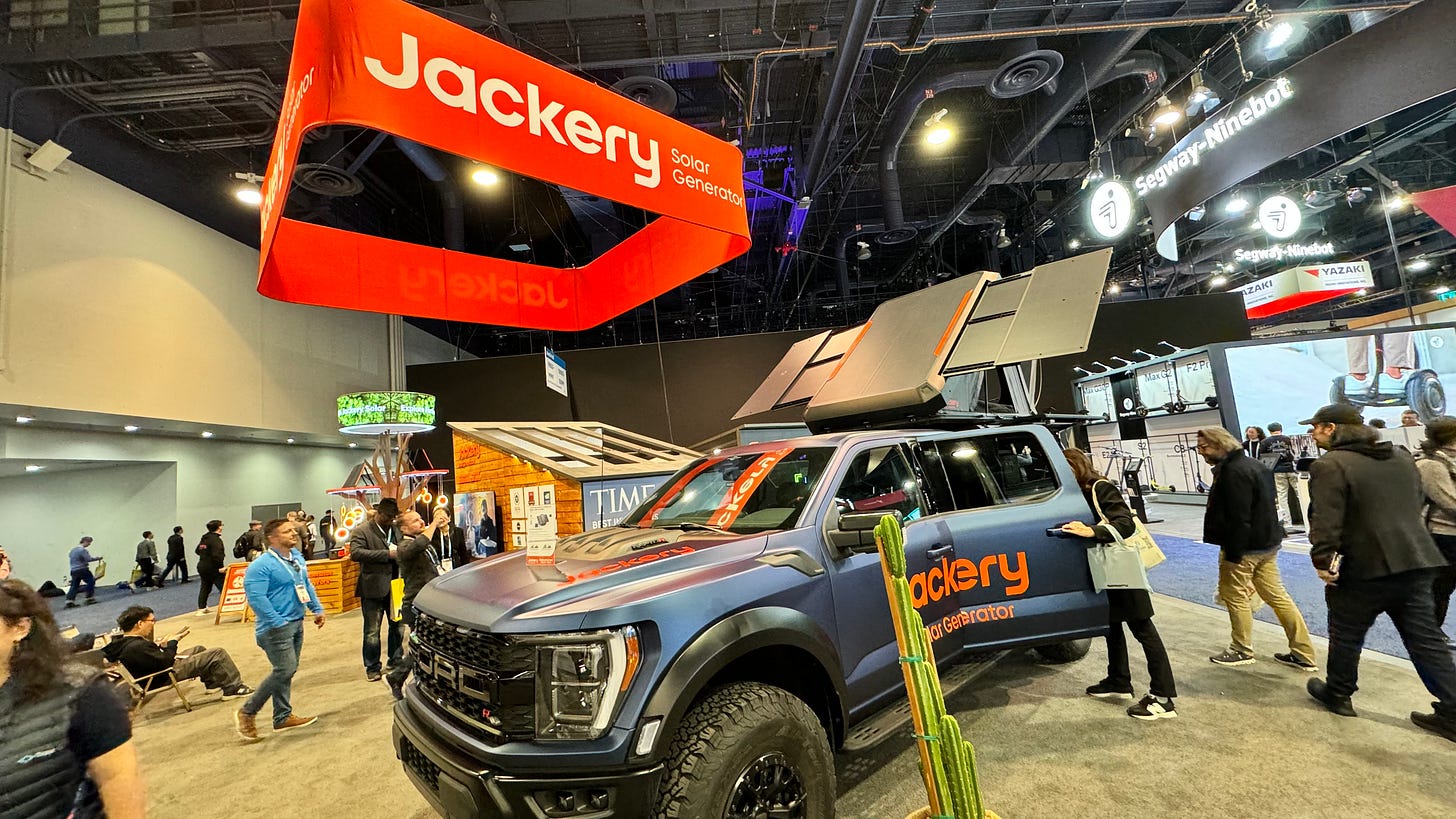


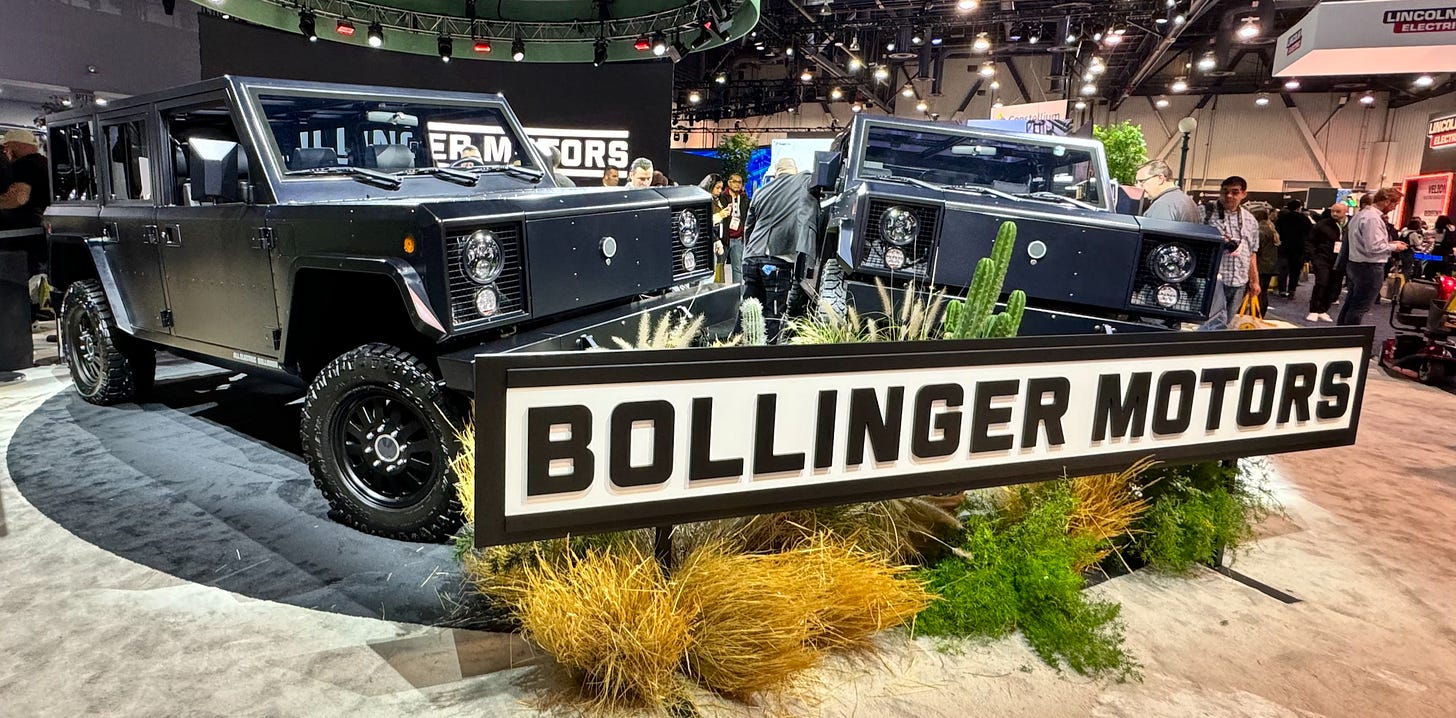
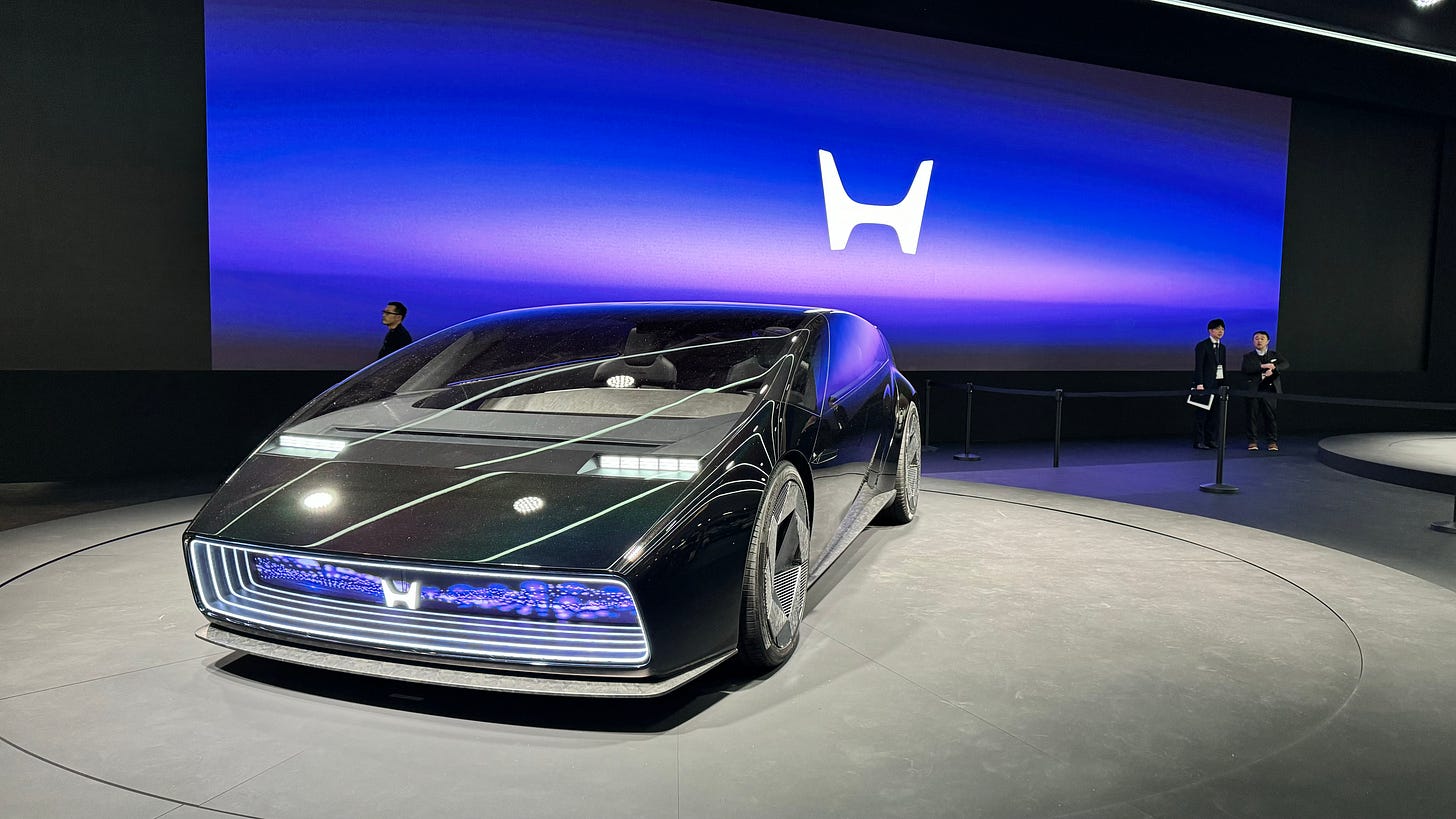
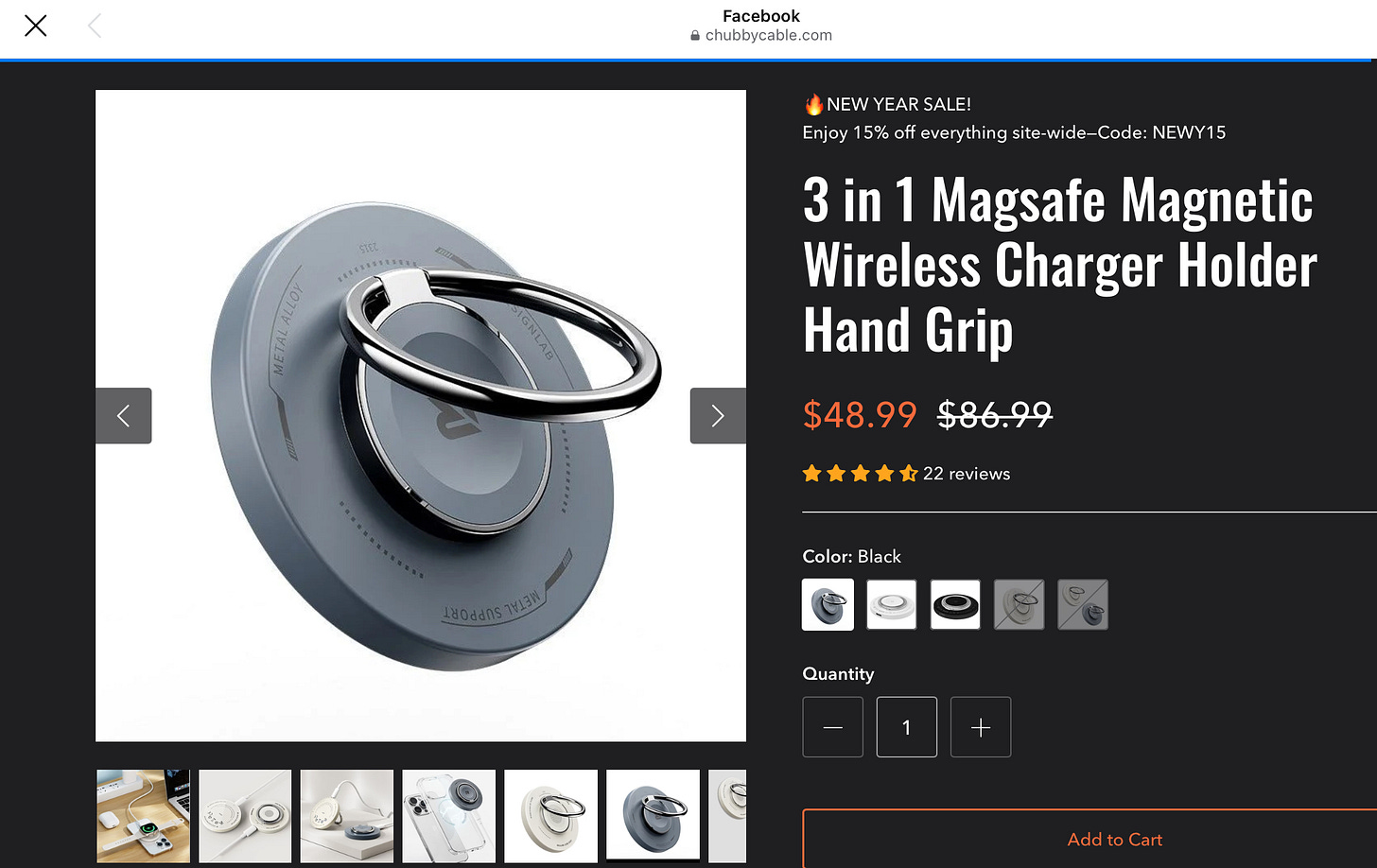
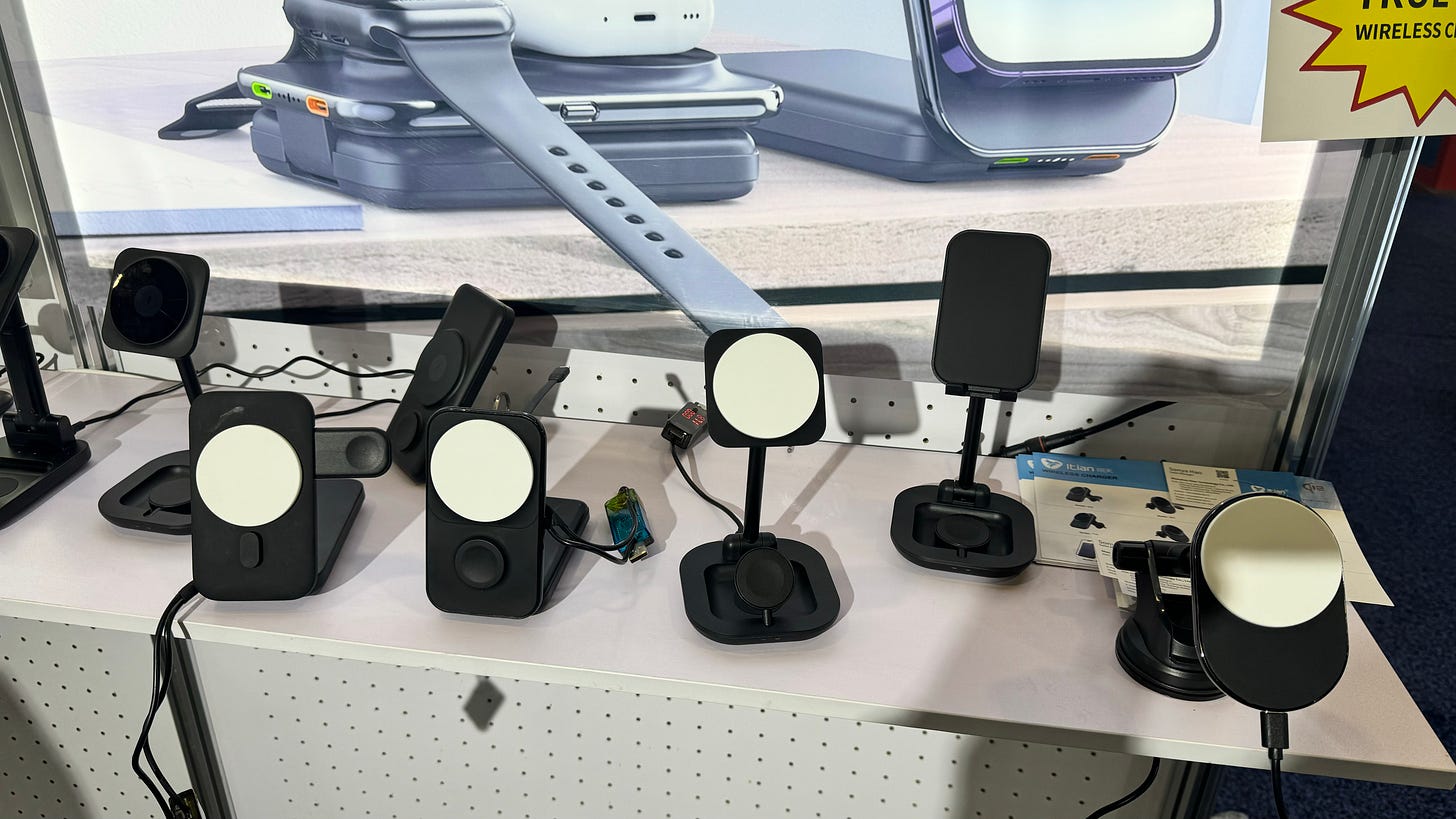



Thanks for the review ! I was also at CES but missed the WestGate area with EInk Sharp Display. Did you get a business card in order to know more and may be order ? Price, Size, how many refresh/days, ...
I think if the colors are vivid enought and price no so expensive it could be very interesting. I remember seeing an Indian startup doing eInk + Photovoltaic at CES2019
I'll be honest - my hot take was that the reports (I didn't go myself) coming our of CES were underwhelming - but I've been converted by the argument of the steady evolution. I loved the point you made using the Devil Wears Prada clip. I'll keep that in mind next time I think "it's just gadgets and stuff".